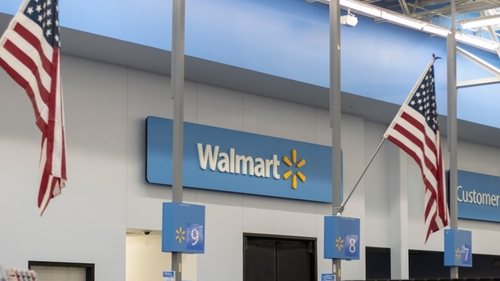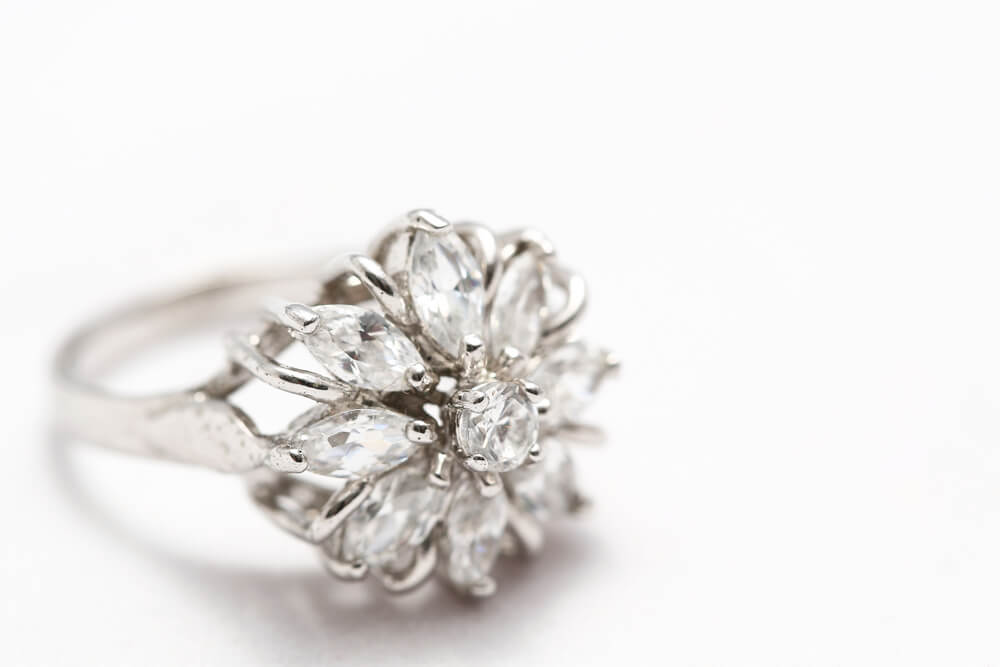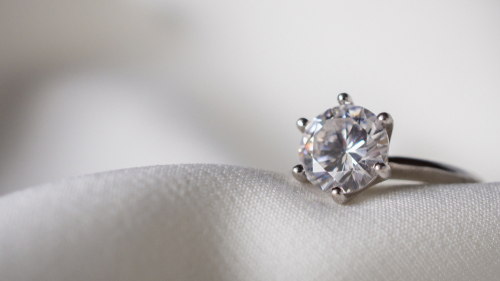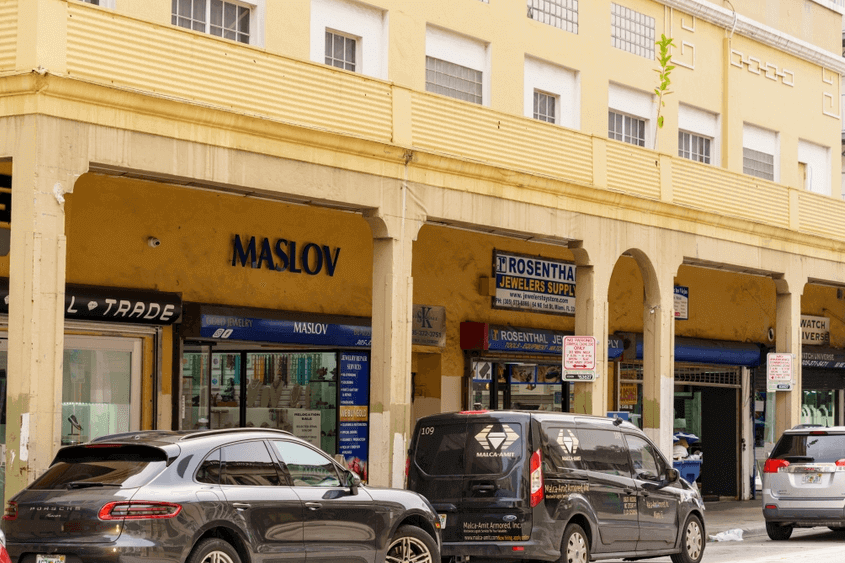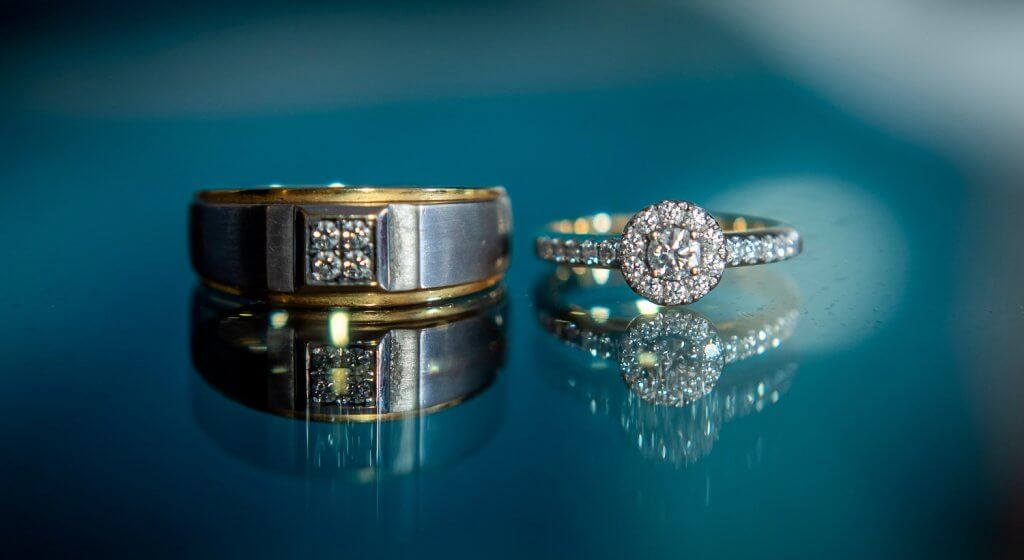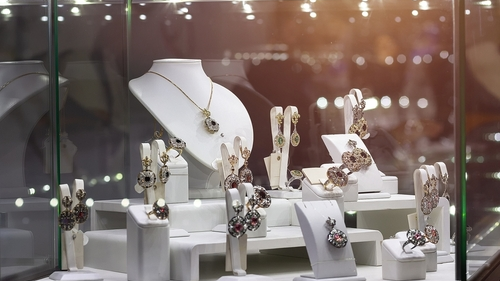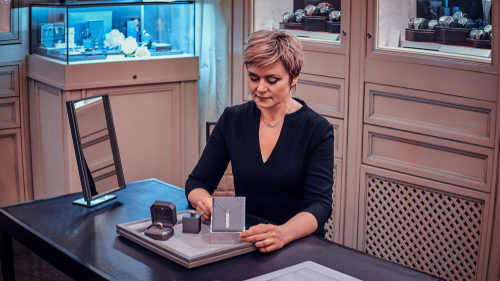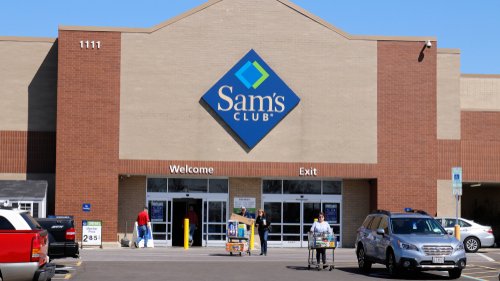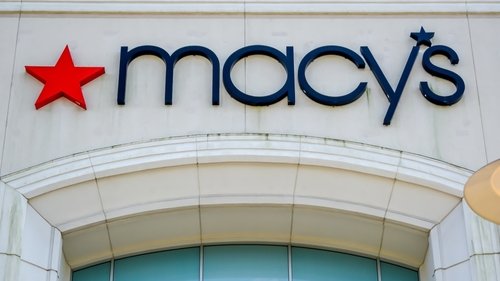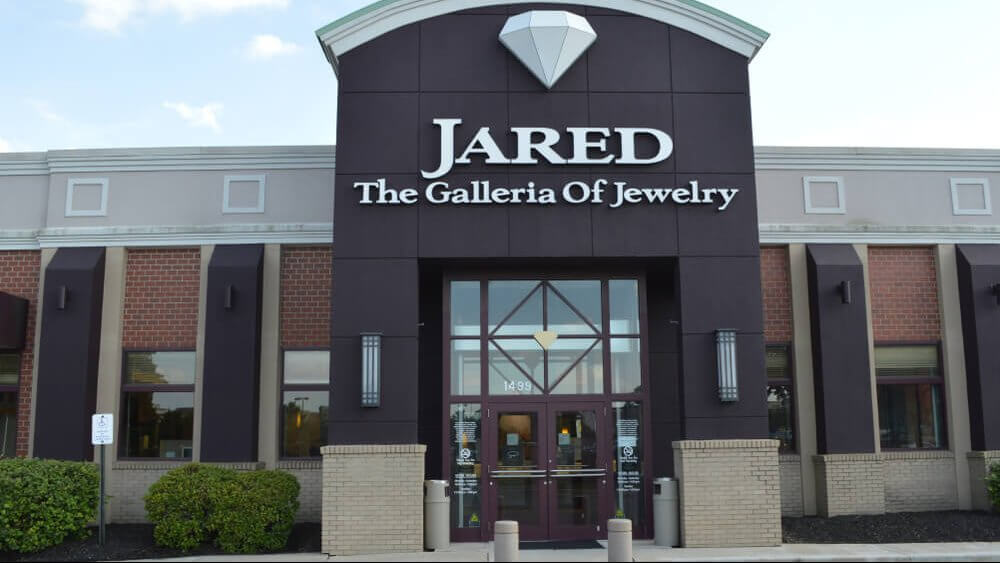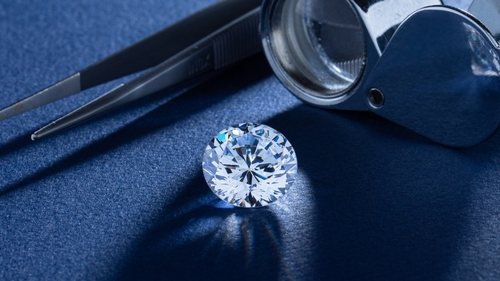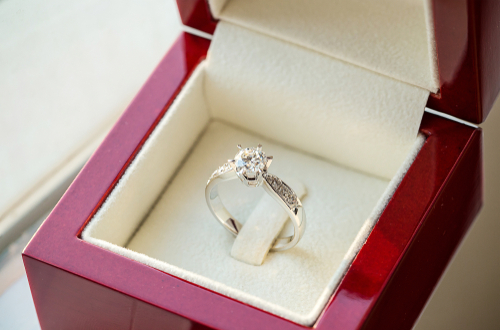74.4% Score | From Kiss to Forever: The Kay Engagement Ring
When it comes to finding the perfect engagement ring, Kay Jewelers offers a wide selection that combines timeless style with modern elegance. Dive into our detailed review to discover how Kay’s engagement rings stack up in terms of quality, settings, and value.
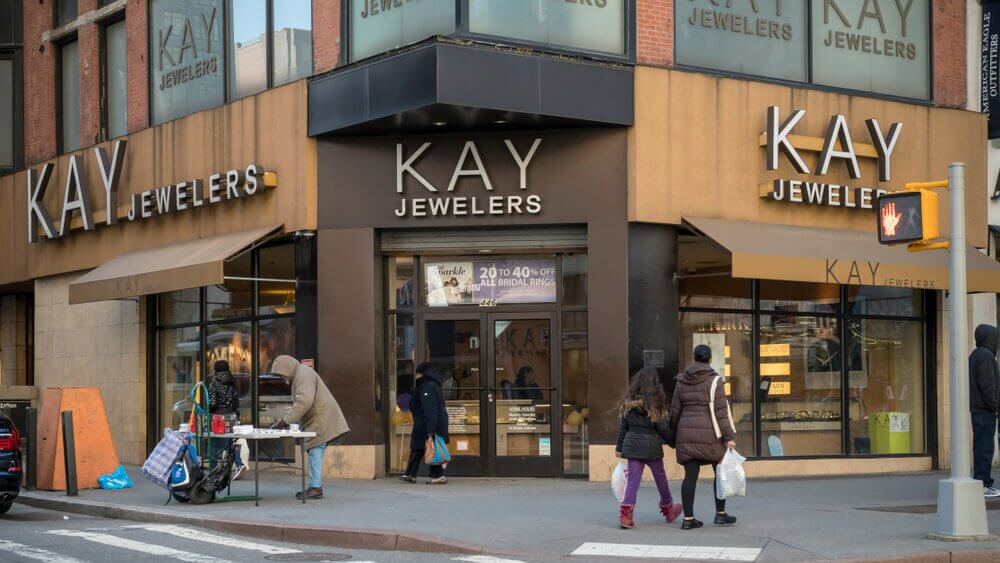
In this comprehensive review, we’ll explore:
- The Diamonds in Kay Jewelers Engagement Rings
- Styles and Settings: Finding Your Perfect Match
- Conclusion
- Buying Guide to Shopping at Kay Jewelers
- 7 FAQs
- Kay Jewelers Overall Sentiment and Positivity Score – 74.4%
- Kay Jewelers Store Directory: Locations and Sentiment Scores
Introduction to Kay Jewelers Engagement Rings
It’s safe to say that the world has moved on from the heyday of the great American mall – and, as a result, that most of us are pretty quick to write off names like Kay Jewelers as relics from a bygone era, easily evoked by the smell of a Cinnabon stall or the multi-layered echo of the atrium on a busy Saturday morning.
Sure, there are some great memories attached to those days but, at the same time, they feel a little out of date. Stores that considered the mall their stomping ground – stores like Zales and Kay Jewelers – are, and always were, an obvious choice.
With that being said, is it really so wrong to go with the obvious choice? There are certain things that Kay Jewelers seem to have fallen behind on, but the world of fine jewelry and the process of finding an engagement ring hasn’t left them behind just yet.
In other words, we’re not going to pretend that Kay Jewelers is anything groundbreaking – or that it’s even changed much since the last time you walked through their doors, or stopped to stare into their window. What we’re also not going to do, however, is write off Kay Jewelers altogether simply because it’s part of an ‘older way’ of doing things. The ‘new way’ is, in our opinion, a far worse option…
The Backstory to “Every Kiss Begins With Kay” and Kay Jewelers Engagement Rings
Kay Jewelers is one of a number of major American jewelry store chains owned by the industry giant, Signet Jewelers. We have reviewed its sister companies, Zales and Jared Jewelers, and found a number of similarities (as well as a number of differences) between them. While Zales is a good all-rounder for finding gifts for Valentine’s, Mother’s Day, birthdays and Christmas, Jared is a little more up-market – a little more prestigious thanks to its typical placement outside of malls, rather than crammed between a Victoria’s Secret and a Footlocker.
But we’re here to talk about Kay Jewelers – once again, a big name on the mall circuit, but still sufficiently independent from its siblings that it’s got plenty of talking points of its own.
Kay Jewelers was initially founded more than a hundred years ago, in Pennsylvania. The year was 1916, and the business – owned by the Kaufmann family – sold a wide array of items, from furnishings to decorative items and, as you can imagine, jewelry.
Unfortunately, not much else is known about Kay Jewelers’ early beginnings. The store passed into the second generation – brothers Sol and Edmund, who found far greater promise in the store’s jewelry section than any other – and, eventually, became one of Signet Jewelers’ key players in the American market. These days, Kay Jewelers boasts more than 1,000 locations across the country and a name that is likely to be one of the first that pops into our heads when we think of jewelry.
It seems almost inevitable that that represents an Achilles heel of sorts. The obvious choice is the safe choice – and the safe choice becomes, in time, a pretty generic and even unimaginative option, particularly with the industry thriving creatively as it is now.
We can, however, still see a lot to commend in a store like Kay’s. Sure, it’s not one of the highest-rated stores – nowhere near, in fact – but it’s got a lot more going for it than plenty of others…
Kay Jewelers Engagement Rings: The Legacy
Kay Jewelers may have branched out into ecommerce in more recent years, but they will probably always be known as a familiar face in the mall. In many parts of the country, shoppers can walk in and have that traditional experience. They can look in the case, see the diamonds move and sparkle on the back of their hand, talk to the jeweler, and experience their options, rather than just pointing and clicking. If you’re considering other options, you might want to explore a jewelry store near you to see how they compare with Kay Jewelers.
Of course, we’re big proponents of online shopping for an engagement ring. That is: when it’s done in the right way. We have carefully engineered the entire process using an AI tool to ensure that customers get that experience, even though they’re not standing in a jewelry store. A lot of other online vendors can offer that type of experience.
So, compared with some online vendors, Kay Jewelers has the edge.
Now, Kay Jewelers is not a luxury, high-end brand, but that’s as much a benefit as it is a downside. The high-end luxury brands are overpriced, and not the right places to turn to if you want to get the best diamond possible for your investment.
We’re more than willing to admit, of course, that in order to get the best possible diamond for your investment, you’d really need to have to do your research before heading into a Kay Jewelers. They’re lacking that finesse when it comes to selecting the very best diamonds for their customers and, in our opinion, seem to be taking a more ‘try everything and see what sticks’ approach. Clearly, it works for them – but, in order to make Kay Jewelers work for you, you’d have to prepare yourself with a list of non-negotiables first.
The Diamonds in Kay Jewelers Engagement Rings
This is where our review takes a downturn. We’ve talked up the in-store experience that Kay Jewelers can offer, but don’t let that make you complacent when it comes to the diamonds themselves.
Buying a good diamond is a combination of two things, alongside researching the basics of quality beforehand. First, you want to be able to see it – second, you want to be able to fall back on the report to understand the things you can’t see (and, to an extent, the things you can).
We’re talking, of course, about diamond certification – those independently created reports provided by third parties, detailing the specifics of a diamond’s Four Cs (Cut, Color, Clarity and Carat weight) as well as other aspects impacting its appearance and light performance, like proportion and fluorescence. These third-party gemological laboratories are all aimed toward providing the same service, but their methods are totally different from one another’s, and the results often wind up being wildly different depending on what lab your diamond is sent off to.
Natural diamonds you look at should be GIA certified. The GIA is widely regarded as the best choice, primarily because of its fair and unbiased approach. It was initially founded to bring transparency to shoppers who didn’t know much about the diamonds they were buying and remains true to that original philosophy to this day.
Shoppers who look at GIA diamonds can feel sure that they’re not being led to believe that the diamond they’re being shown is worth more than it is, which, as you can imagine, is an invaluable lifeline for many, many people around the world who aren’t trained in gemology.
At Kay Jewelers, the majority of their (certified) diamonds feature reports from the IGI, rather than the GIA…
Understanding Diamond Quality: IGI Reports
The IGI, or the International Gemological Institute, is geared up to produce reports on much higher volumes than the GIA. They invest less time into each diamond, which reduces turnaround time for vendors looking to acquire certification and, as a result, represents an ideal alternative to the slower, more exacting (and more expensive) labs.
The trouble with churning out reports like a factory line is that it risks increasing the opportunity for human error, or general inconsistencies. In the past, independent investigations have demonstrated evidence of these inconsistencies. Even our own investigation made clear the trouble with using the IGI rather than the IGI.
For more information, you can read our full guide to IGI diamonds. While it’s not the worst lab we’ve discussed, the service it offers seems to offer significantly more benefit to vendors (i.e., in this instance, Kay Jewelers themselves) rather than the shopper. The only apparent benefit is a slightly reduced cost since certification is cheaper and not so highly regarded, but you’ve got to question whether that reduced cost will be offset by the potential overinvestment shoppers make into IGI diamonds.
Styles and Settings: Finding Your Perfect Match
As you can probably guess, a store of Kay’s size and prominence offers an incredibly wide range of ring settings. There are plenty of classics – halos, solitaires, three-stone settings, and budget-friendly clusters – but we didn’t see anything truly innovative or groundbreaking. It’s not that we expected to – stores like Kays are successful at what they do and don’t need to revolutionize jewelry design when so many of their customers turn to them because of the fact that they know exactly what to expect. Plenty of jewelry stores stick to the tried-and-tested favorites, so we’re not going to fault them for that.
One of the most impressive parts of their offering is their Custom Jewelry Design studio, where you can bring a sketch – or even just an idea – into one of their stores, and consult with their craftsmen to bring it to life.
They offer a digital version of this – an online ring builder almost identical to those of the big online vendors – but it’s limited.
That is, after all, another issue all the big stores have – the pressure to ensure consistency across more than a thousand stores. Zales employs many, many sales associates, consultants, and jewelers to man their stores, and working toward a strong and consistent experience across the entire country inevitably means that they won’t be able to equip their staff with the same levels of expertise, passion, or creativity that you’ll find in a smaller, local jewelry store.
Triumphs: When Kay Exceeds Expectations
Kay Jewelers is a definite giant of the industry. It is impressive how they have grown over the years, and there’s no doubt they have helped to create countless perfect moments between couples, friends, and family members. We can’t help but feel a little nostalgic when we happen to find ourselves in the mall, walking past their doors, for the holiday seasons and Valentine’s Days past.
With more than a thousand locations and a sentimental pull that many Americans feel, it’s a shame we can’t give Zales – or their sister companies – higher ratings.
Challenges: Learning from Customer Feedback
IGI diamonds are poor investments and, given the fact that the overwhelming majority of diamonds on sale at Kay Jewelers seem to have been graded by the IGI, it stands to reason that we would consider them to be poor investments.
Kay Jewelers also sell pieces featuring low-cost diamond alternatives like cubic zirconia, moissanite, and white sapphire. These three gemstones all offer relatively convincing alternatives from a distance – although, up close, the differences between them and real diamonds are clear to see, even if you’re not an expert (or even particularly experienced with looking at diamonds).
Conclusion
While they don’t carry quite the same weight in the jewelry world as the luxury, high-end retailers, Kay Jewelers do offer a more accessible option for anyone looking to fit their budget to a beautiful engagement ring.
There’s plenty to like about these stores, even if they are a little ‘cookie cutter’. It’s not the ideal experience for someone looking to buy the most beautiful engagement ring possible, but it’s not the worst, either.
What lets them down most is the emphasis they place on IGI diamonds. This lab is nowhere near as beneficial to shoppers as the GIA or AGS, and we can’t recommend you opt for a diamond graded in this way.
Buying Guide For Finding the Perfect Engagement Ring at Kay’s Jewelers:
- Understand the 4Cs
- Carat Weight: Remember, size is not the only indicator of a diamond’s value. While a larger carat weight might seem more impressive, it’s essential to consider all the 4Cs together.
- Cut Quality: The cut of a diamond affects its brilliance more than anything else. A well-cut diamond will sparkle magnificently, even if it’s smaller. Look for cuts that enhance the stone’s natural beauty and reflect light dazzlingly.
- Clarity: While searching through Kay’s collection, pay attention to the clarity of the diamonds. Minor imperfections can often go unnoticed by the naked eye but can significantly affect the price. Choose a clarity grade that offers the best value for what is visible.
- Color: Diamond color can range from colorless to a faint yellow hue. Opt for a diamond that appears white in relation to its setting to ensure a dazzling appearance.
- Review Certification and Grading
Every diamond at Kay Jewelers comes with a promise of quality. However, reviewing the certification for your chosen engagement ring is crucial. Certifications from reputable labs offer an unbiased assessment of the diamond’s quality and characteristics. - Explore Settings and Styles
Kay Jewelers offers a multitude of settings and styles. Whether you prefer a traditional solitaire, a glamorous halo, or a vintage-inspired design, considering your partner’s lifestyle and personal taste will help you select a ring that’s both beautiful and practical. - Consider the Metal
The metal you choose for the band plays a significant role in the ring’s overall look and durability. From the classic elegance of gold to the modern appeal of platinum, each metal has its unique advantages. Consider which metal complements the diamond and matches your partner’s daily wear. - Compare and Contrast
Take your time to browse and compare different engagement rings within Kay’s vast collection. Use their online resources or visit multiple locations to see the rings in person. Seeing various options side by side can help crystallize what you’re looking for in the perfect engagement ring. - Reflect on the Warranty and Care Services
Understanding the warranty and care services that come with your purchase can provide peace of mind. Kay Jewelers offers protection plans and services to maintain the beauty and integrity of your engagement ring over time. Ensure you’re aware of what’s covered and how to maintain your ring’s brilliance.
7 Frequently Asked Questions About Kay Jewelers Engagement Rings
- What types of engagement rings does Kay Jewelers offer?
Kay Jewelers offers a wide range of engagement rings, including solitaire, halo, three-stone, vintage, and modern designs, as well as custom engagement ring options. They feature diamonds and a variety of gemstones set in different metals like gold, platinum, and sterling silver. - Are Kay Jewelers diamonds conflict-free?
Yes, Kay Jewelers ensures that their diamonds are conflict-free, adhering to the Kimberley Process and other strict industry standards. They are committed to ethical sourcing and responsible jewelry practices. - Can I customize an engagement ring at Kay Jewelers?
Absolutely! Kay Jewelers provides a custom design service that allows you to create a personalized engagement ring. You can choose the setting, stone, and metal to match your preferences and budget. - Does Kay Jewelers offer financing options for engagement ring purchases?
Yes, Kay Jewelers offers various financing options to make purchasing an engagement ring more manageable. Options include special financing plans with the Kay Jewelers Credit Card, subject to credit approval and terms. - How can I find the right ring size when purchasing an engagement ring from Kay Jewelers?
Kay Jewelers offers a free ring sizing tool online and in-store assistance to help you determine the perfect ring size. It’s important to ensure a comfortable and secure fit for your engagement ring. - Does Kay Jewelers provide warranties or protection plans for engagement rings?
Kay offers comprehensive care plans and warranties for engagement rings, which cover routine maintenance, repairs, and even diamond replacement under certain conditions. Ask for details when making your purchase. - Can I return or exchange an engagement ring purchased from Kay Jewelers?
Kay Jewelers has a return and exchange policy that allows you to return or exchange your engagement ring within a specified period, provided it’s in its original condition and accompanied by the receipt. It’s advisable to review their return policy for specific terms and conditions.
Kay Jewelers Overall Sentiment and Positivity Score – 74.4%
As part of our comprehensive review, we’ve reviewed an extensive dataset of 109,453 customer reviews from across the web to create a Positivity Score for Kay Jewelers. This score represents the percentage of positive reviews for each of Kay’s 952 locations, reflecting the real experiences of shoppers nationwide. We averaged all scores into a Grand Positivity Score. The Grand Positivity Score for the entire chain stands at 74.4%, offering insight into the general customer satisfaction levels at their stores.
To help you make a more informed decision, we’ve compiled a detailed list of each Kay Jewelers store and its individual score. Explore the rankings below to find out how your local Kay Jewelers measure up.
Kay Jewelers Store Directory: Locations and Sentiment Scores
Alaska (AK)
- Kay Jewelers – Anchorage 5th Avenue Mall, Anchorage AK – 72.0%
- Kay Jewelers – Dimond Center, Anchorage AK – 80.0%
Alabama (AL)
- Kay Jewelers – Colonial Promenade Alabaster, Alabaster AL – 70.0%
- Kay Jewelers – Shoppes Of Albertville, Albertville AL – 87.5%
- Kay Jewelers – French Farms Pavilion, Athens AL – 75.0%
- Kay Jewelers – Auburn Mall, Auburn AL – 67.0%
- Kay Jewelers – Colonial Promenade Tannehill, Bessemer AL – 60.0%
- Kay Jewelers – Riverchase Galleria, Birmingham AL – 71.0%
- Kay Jewelers – Marketplatz, Cullman AL – 90.0%
- Kay Jewelers – Jubilee Square, Daphne AL – 77.5%
- Kay Jewelers – Market Shoppes, Decatur AL – 70.0%
- Kay Jewelers – Wiregrass Commons Mall, Dothan AL – 84.0%
- Kay Jewelers – Enterprise Shopping Center, Enterprise AL – 85.0%
- Kay Jewelers – Florence Mall, Florence AL – 90.0%
- Kay Jewelers – Colonial Promenade Fultondale, Fultondale AL – 80.0%
- Kay Jewelers – The Shoppes On Meighan, Gadsden AL – 71.5%
- Kay Jewelers – Parkway Place, Huntsville AL – 60.0%
- Kay Jewelers – Bridge Street Town Centre, Huntsville AL – 82.5%
- Kay Jewelers – Shoppes Of Madison, Madison AL – 75.0%
- Kay Jewelers – Shoppes At Bel Air, Mobile AL – 90.0%
- Kay Jewelers – Eastchase Outparcel, Montgomery AL – 75.0%
- Kay Jewelers – Quintard Mall, Oxford AL – 90.0%
- Kay Jewelers – High Point Town Center, Prattville AL – 90.0%
- Kay Jewelers – Pinnacle At Tutwiler Farm, Trussville AL – 92.0%
- Kay Jewelers – University Mall, Tuscaloosa AL – 90.0%
Arkansas (AR)
- Kay Jewelers – Shoppes Of Benton, Benton AR – 90.0%
- Kay Jewelers – Lewis Crossing Shopping Center, Conway AR – 81.0%
- Kay Jewelers – Northwest Arkansas Mall, Fayetteville AR – 82.5%
- Kay Jewelers – Central Mall, Fort Smith AR – 70.0%
- Kay Jewelers – Buena Vista Plaza, Hot Springs AR – 85.0%
- Kay Jewelers – Park Plaza, Little Rock AR – 90.0%
- Kay Jewelers – Mccain Mall, North Little Rock AR – 85.0%
- Kay Jewelers – Pinnacle Hills Promenade, Rogers AR – 82.5%
Arizona (AZ)
- Kay Jewelers – Gateway Crossing, Avondale AZ – 90.0%
- Kay Jewelers – Chandler Fashion Center, Chandler AZ – 67.5%
- Kay Jewelers – Flagstaff Mall, Flagstaff AZ – 65.0%
- Kay Jewelers – Santan Village, Gilbert AZ – 70.0%
- Kay Jewelers – Arrowhead Towne Center, Glendale AZ – 70.0%
- Kay Jewelers – Shops At Lake Havasu, Lake Havasu AZ – 75.0%
- Kay Jewelers – Superstition Springs Center, Mesa AZ – 55.0%
- Kay Jewelers – Desert Ridge Marketplace, Phoenix AZ – 65.0%
- Kay Jewelers – Prescott Valley Crossroads, Prescott Valley AZ – 75.0%
- Kay Jewelers – Qc District, Queen Creek AZ – 75.0%
- Kay Jewelers – Scottsdale Fashion Square, Scottsdale AZ – 65.0%
- Kay Jewelers – The Mall At Sierra Vista, Sierra Vista AZ – 76.0%
- Kay Jewelers – Tucson Mall, Tucson AZ – 50.0%
- Kay Jewelers – Park Place, Tucson AZ – 75.0%
- Kay Jewelers – Tucson Spectrum, Tucson AZ – 88.0%
- Kay Jewelers – Yuma Palms Regional Center, Yuma AZ – 85.0%
California (CA)
- Kay Jewelers – Valley Plaza, Bakersfield CA – 59.5%
- Kay Jewelers – Brea Mall, Brea CA – 72.5%
- Kay Jewelers – Shoppes At Carlsbad, Carlsbad CA – 67.5%
- Kay Jewelers – Southbay Pavilion, Carson CA – 75.0%
- Kay Jewelers – Los Cerritos Center, Cerritos CA – 70.0%
- Kay Jewelers – Chico Mall, Chico CA – 70.0%
- Kay Jewelers – Sunrise Mall, Citrus Heights CA – 70.0%
- Kay Jewelers – The Center, Clovis CA – 60.0%
- Kay Jewelers – Sunvalley, Concord CA – 50.0%
- Kay Jewelers – Westfield Culver City, Culver City CA – 65.0%
- Kay Jewelers – Serramonte Center, Daly City CA – 72.5%
- Kay Jewelers – Stonewood Center, Downey CA – 59.0%
- Kay Jewelers – Eastvale Gateway III, Eastvale CA – 55.0%
- Kay Jewelers – Parkway Plaza, El Cajon CA – 60.0%
- Kay Jewelers – Imperial Valley Mall, El Centro CA – 87.5%
- Kay Jewelers – Westfield North County, Escondido CA – 52.5%
- Kay Jewelers – Bayshore Mall, Eureka CA – 80.0%
- Kay Jewelers – Solano Town Center, Fairfield CA – 65.5%
- Kay Jewelers – Fashion Fair, Fresno CA – 65.0%
- Kay Jewelers – Hanford Mall, Hanford CA – 80.0%
- Kay Jewelers – Southland Mall, Hayward CA – 35.0%
- Kay Jewelers – Irvine Spectrum Center, Irvine CA – 50.0%
- Kay Jewelers – Lakewood Center, Lakewood CA – 70.0%
- Kay Jewelers – Vintage Faire Mall, Modesto CA – 65.0%
- Kay Jewelers – Montclair Place, Montclair CA – 70.0%
- Kay Jewelers – Shops At Montebello, Montebello CA – 90.0%
- Kay Jewelers – Moreno Valley Mall, Moreno Valley CA – 75.0%
- Kay Jewelers – Westfield Plaza Bonita, National City CA – 72.5%
- Kay Jewelers – Newpark Mall, Newark CA – 70.0%
- Kay Jewelers – Northridge Fashion Center, Northridge CA – 72.5%
- Kay Jewelers – Westfield Palm Desert, Palm Desert CA – 80.0%
- Kay Jewelers – Antelope Valley Mall, Palmdale CA – 82.5%
- Kay Jewelers – Stoneridge Shopping Center, Pleasanton CA – 72.5%
- Kay Jewelers – Victoria Gardens, Rancho Cucamonga CA – 77.5%
- Kay Jewelers – Mountain Grove At Citrus Park, Redlands CA – 75.0%
- Kay Jewelers – Galleria At Tyler, Riverside CA – 65.0%
- Kay Jewelers – Arden Fair, Sacramento CA – 70.0%
- Kay Jewelers – Northridge Mall, Salinas CA – 70.0%
- Kay Jewelers – Inland Center, San Bernardino CA – 82.5%
- Kay Jewelers – Westfield Mission Valley, San Diego CA – 55.0%
- Kay Jewelers – Fashion Valley Mall, San Diego CA – 75.0%
- Kay Jewelers – Stonestown Galleria, San Francisco CA – 60.0%
- Kay Jewelers – Westfield Oakridge, San Jose CA – 70.0%
- Kay Jewelers – Eastridge, San Jose CA – 60.0%
- Kay Jewelers – Hillsdale Shopping Center, San Mateo CA – 57.5%
- Kay Jewelers – Mainplace Mall, Santa Ana CA – 67.5%
- Kay Jewelers – Westfield Valley Fair, Santa Clara CA – 57.5%
- Kay Jewelers – Santa Maria Town Center, Santa Maria CA – 53.5%
- Kay Jewelers – Santa Rosa Plaza, Santa Rosa CA – 32.5%
- Kay Jewelers – Weberstown Mall, Stockton CA – 70.0%
- Kay Jewelers – Promenade Temecula, Temecula CA – 65.0%
- Kay Jewelers – Oaks, Thousand Oaks CA – 72.5%
- Kay Jewelers – Del Amo Fashion Center, Torrance CA – 72.5%
- Kay Jewelers – West Valley Mall, Tracy CA – 40.0%
- Kay Jewelers – Pacific View, Ventura CA – 85.5%
- Kay Jewelers – Mall Of Victor Valley, Victorville CA – 82.5%
- Kay Jewelers – Visalia Mall, Visalia CA – 72.5%
- Kay Jewelers – Plaza West Covina, West Covina CA – 77.5%
- Kay Jewelers – Westminster Mall, Westminster CA – 77.5%
- Kay Jewelers – Yuba Sutter Mall, Yuba City CA – 66.0%
Colorado (CO)
- Kay Jewelers – Southlands, Aurora CO – 70.0%
- Kay Jewelers – Town Center At Aurora, Aurora CO – 47.5%
- Kay Jewelers – Flatiron Crossing, Broomfield CO – 40.0%
- Kay Jewelers – Chapel Hills Mall, Colorado Springs CO – 62.5%
- Kay Jewelers – Citadel, Colorado Springs CO – 72.5%
- Kay Jewelers – Cherry Creek Shopping Center, Denver CO – 70.0%
- Kay Jewelers – Mesa Mall, Grand Junction CO – 79.5%
- Kay Jewelers – Centerplace Of Greeley, Greeley CO – 76.0%
- Kay Jewelers – Southwest Plaza, Littleton CO – 74.0%
- Kay Jewelers – The Promenade Shops @ Centerra, Loveland CO – 77.5%
- Kay Jewelers – Pueblo Mall, Pueblo CO – 72.5%
- Kay Jewelers – Orchard Town Center, Westminster CO – 50.0%
Connecticut (CT)
- Kay Jewelers – Bristol Plaza, Bristol CT – 89.5%
- Kay Jewelers – Danbury Fair, Danbury CT – 82.5%
- Kay Jewelers – Crossing At Killingly Commons, Dayville CT – 77.5%
- Kay Jewelers – Westfarms, Farmington CT – 72.5%
- Kay Jewelers – Shoppes At Buckland Hills, Manchester CT – 70.0%
- Kay Jewelers – Meriden Mall, Meriden CT – 70.0%
- Kay Jewelers – Connecticut Post Mall, Milford CT – 77.5%
- Kay Jewelers – Sono Collection, Norwalk CT – 88.0%
- Kay Jewelers – Stamford Town Center, Stamford CT – 76.0%
- Kay Jewelers – Westfield Trumbull, Trumbull CT – 72.0%
- Kay Jewelers – Brass Mill Center, Waterbury CT – 73.5%
- Kay Jewelers – Crystal Mall, Waterford CT – 82.5%
- Kay Jewelers – Wethersfield Shopping Plaza, Wethersfield CT – 94.0%
Delaware (DE)
- Kay Jewelers – Dover Mall & Commons, Dover DE – 87.5%
- Kay Jewelers – Westown Towne Center, Middletown DE – 91.0%
- Kay Jewelers – Christiana Mall, Newark DE – 50.0%
- Kay Jewelers – Concord Mall, Wilmington DE – 75.0%
Florida (FL)
- Kay Jewelers – Altamonte Mall, Altamonte Springs FL – 60.0%
- Kay Jewelers – Aventura Mall, Aventura FL – 77.5%
- Kay Jewelers – Town Center At Boca Raton, Boca Raton FL – 75.0%
- Kay Jewelers – Boynton Beach Mall, Boynton Beach FL – 59.0%
- Kay Jewelers – Fresh Market Promenade, Bradenton FL – 82.5%
- Kay Jewelers – Westfield Brandon, Brandon FL – 90.0%
- Kay Jewelers – Coastal Way – Coastal Landing, Brooksville FL – 70.0%
- Kay Jewelers – Coral Walk, Cape Coral FL – 87.5%
- Kay Jewelers – Westfield Countryside, Clearwater FL – 85.0%
- Kay Jewelers – Clermont Landing, Clermont FL – 80.5%
- Kay Jewelers – Coral Square, Coral Springs FL – 40.0%
- Kay Jewelers – Posner Park, Davenport FL – 61.0%
- Kay Jewelers – Volusia Mall, Daytona Beach FL – 70.0%
- Kay Jewelers – Destin Commons, Destin FL – 82.5%
- Kay Jewelers – Edison Mall, Fort Myers FL – 72.5%
- Kay Jewelers – Gulf Coast Town Center, Fort Myers FL – 52.0%
- Kay Jewelers – Cypress Woods, Fort Myers FL – 90.0%
- Kay Jewelers – Oaks Mall, Gainesville FL – 87.5%
- Kay Jewelers – Westland Mall, Hialeah FL – 94.0%
- Kay Jewelers – Atlantic West Shopping Center, Jacksonville FL – 75.0%
- Kay Jewelers – Avenues, Jacksonville FL – 77.5%
- Kay Jewelers – River City Marketplace, Jacksonville FL – 68.5%
- Kay Jewelers – St. Johns Town Center, Jacksonville FL – 74.0%
- Kay Jewelers – Treasure Coast Square, Jensen Beach FL – 87.5%
- Kay Jewelers – Loop/Loop West, Kissimmee FL – 67.0%
- Kay Jewelers – Rolling Acres Plaza, Lady Lake FL – 90.0%
- Kay Jewelers – Lake City Mall, Lake City FL – 81.0%
- Kay Jewelers – Eagle Ridge Mall, Lake Wales FL – 67.5%
- Kay Jewelers – Lakeland Square Mall, Lakeland FL – 62.5%
- Kay Jewelers – Hutton Lakeland, Lakeland FL – 83.0%
- Kay Jewelers – Via Port Florida, Leesburg FL – 50.0%
- Kay Jewelers – Santa Rosa Mall, Mary Esther FL – 82.5%
- Kay Jewelers – Melbourne Square, Melbourne FL – 55.5%
- Kay Jewelers – Avenue Viera, Melbourne FL – 80.0%
- Kay Jewelers – Miami International Mall, Miami FL – 77.5%
- Kay Jewelers – Southland Mall, Miami FL – 87.5%
- Kay Jewelers – The Falls, Miami FL – 90.0%
- Kay Jewelers – Dadeland Mall, Miami FL – 69.0%
- Kay Jewelers – Lake Louise Plaza, Mount Dora FL – 70.0%
- Kay Jewelers – Coastland Center, Naples FL – 85.0%
- Kay Jewelers – Cocoplum Village Shops, North Port FL – 87.0%
- Kay Jewelers – Paddock Mall, Ocala FL – 77.5%
- Kay Jewelers – Six Guns Plaza, Ocala FL – 90.0%
- Kay Jewelers – West Volusia Towne Centre, Orange City FL – 77.5%
- Kay Jewelers – Orange Park Mall, Orange Park FL – 72.5%
- Kay Jewelers – Fleming Island, Orange Park FL – 40.0%
- Kay Jewelers – Florida Mall, Orlando FL – 77.5%
- Kay Jewelers – Waterford Lakes Town Center, Orlando FL – 82.5%
- Kay Jewelers – Pace Highway 90, Pace FL – 90.0%
- Kay Jewelers – Gardens Mall, Palm Beach Gardens FL – 82.5%
- Kay Jewelers – Palm Coast Landing @ Town Cntr, Palm Coast FL – 70.0%
- Kay Jewelers – Pier Park, Panama City Beach FL – 85.0%
- Kay Jewelers – Pembroke Lakes Mall, Pembroke Pines FL – 80.0%
- Kay Jewelers – Cordova Mall, Pensacola FL – 57.5%
- Kay Jewelers – Westfield Broward, Plantation FL – 72.5%
- Kay Jewelers – 23hundred, Pompano Beach FL – 83.0%
- Kay Jewelers – Port Charlotte Town Center, Port Charlotte FL – 50.0%
- Kay Jewelers – Town Center At St. Lucie West, Port Saint Lucie FL – 81.0%
- Kay Jewelers – Hutton Riverview, Riverview FL – 85.0%
- Kay Jewelers – Seminole Towne Center, Sanford FL – 80.0%
- Kay Jewelers – University Town Center, Sarasota FL – 72.0%
- Kay Jewelers – Lowes Outparcel, Sebring FL – 62.5%
- Kay Jewelers – Cobblestone Village, Saint Augustine FL – 85.0%
- Kay Jewelers – Tyrone Square, Saint Petersburg FL – 70.0%
- Kay Jewelers – Governor’s Square, Tallahassee FL – 75.0%
- Kay Jewelers – International Plaza, Tampa FL – 55.0%
- Kay Jewelers – Westshore Plaza, Tampa FL – 82.5%
- Kay Jewelers – Westfield Citrus Park, Tampa FL – 80.0%
- Kay Jewelers – Crossroads Marketplace, Titusville FL – 70.0%
- Kay Jewelers – Mall At Wellington Green, Wellington FL – 60.0%
- Kay Jewelers – Shops At Wiregrass, Wesley Chapel FL – 45.0%
- Kay Jewelers – Winter Garden Village, Winter Garden FL – 62.5%
Georgia (GA)
- Kay Jewelers – Albany Mall, Albany GA – 92.5%
- Kay Jewelers – North Point Mall, Alpharetta GA – 67.5%
- Kay Jewelers – Georgia Square Mall, Athens GA – 63.0%
- Kay Jewelers – Cumberland Mall, Atlanta GA – 57.5%
- Kay Jewelers – Augusta Mall, Augusta GA – 40.0%
- Kay Jewelers – East-West Commons, Austell GA – 86.0%
- Kay Jewelers – Barrow Crossing, Bethlehem GA – 72.0%
- Kay Jewelers – Glynn Isles Market, Brunswick GA – 80.0%
- Kay Jewelers – Mall Of Georgia, Buford GA – 65.0%
- Kay Jewelers – Canton Marketplace, Canton GA – 72.5%
- Kay Jewelers – Mcintosh Plaza, Carrollton GA – 81.0%
- Kay Jewelers – Main Street Shopping Center, Cartersville GA – 82.5%
- Kay Jewelers – Peachtree Mall, Columbus GA – 70.0%
- Kay Jewelers – Conyers Crossroads, Conyers GA – 65.0%
- Kay Jewelers – Dalton Food City Outparcel, Dalton GA – 84.0%
- Kay Jewelers – Arbor Place, Douglasville GA – 80.0%
- Kay Jewelers – Dublin Mall, Dublin GA – 80.0%
- Kay Jewelers – Perimeter Mall, Dunwoody GA – 75.0%
- Kay Jewelers – Camp Creek Marketplace, East Point GA – 78.0%
- Kay Jewelers – Fayette Pavilion, Fayetteville GA – 80.5%
- Kay Jewelers – Parkway Plaza, Fort Oglethorpe GA – 80.0%
- Kay Jewelers – Lakeshore Mall, Gainesville GA – 71.0%
- Kay Jewelers – North Griffin Square, Griffin GA – 81.0%
- Kay Jewelers – Hinesville Central Shop Cntr, Hinesville GA – 60.0%
- Kay Jewelers – Town Center At Cobb, Kennesaw GA – 67.5%
- Kay Jewelers – Lagrange Mall, Lagrange GA – 80.0%
- Kay Jewelers – The Mall At Stonecrest, Lithonia GA – 70.5%
- Kay Jewelers – Shoppes At River Crossing, Macon GA – 77.5%
- Kay Jewelers – Avenue West Cobb, Marietta GA – 72.0%
- Kay Jewelers – Henry Town Center, McDonough GA – 82.5%
- Kay Jewelers – Milledgeville Mall, Milledgeville GA – 82.5%
- Kay Jewelers – Ashley Park, Newnan GA – 80.0%
- Kay Jewelers – The Village On Pooler Parkway, Pooler GA – 78.0%
- Kay Jewelers – Mount Berry Mall, Rome GA – 74.0%
- Kay Jewelers – Oglethorpe Mall, Savannah GA – 85.0%
- Kay Jewelers – The Shoppes At Webb Gin, Snellville GA – 84.0%
- Kay Jewelers – Statesboro Mall, Statesboro GA – 80.0%
- Kay Jewelers – Gateway Shopping Center, Thomasville GA – 82.5%
- Kay Jewelers – Valdosta Mall, Valdosta GA – 90.0%
- Kay Jewelers – Vidalia Central, Vidalia GA – 80.0%
- Kay Jewelers – Willow Lake Crossing, Warner Robins GA – 80.0%
Hawaii (HI)
- Kay Jewelers – Pearlridge Center, Aiea HI – 75.0%
- Kay Jewelers – Prince Kuhio Plaza, Hilo HI – 70.0%
- Kay Jewelers – Ala Moana Center, Honolulu HI – 80.0%
- Kay Jewelers – Queen Ka’ahumanu Center, Kahului HI – 75.0%
- Kay Jewelers – Windward Mall, Kaneohe HI – 65.0%
- Kay Jewelers – Ka Makana Ali’i, Kapolei HI – 80.0%
- Kay Jewelers – Kukui Grove Center, Lihue HI – 85.0%
Iowa (IA)
- Kay Jewelers – North Grand Mall, Ames IA – 82.5%
- Kay Jewelers – Shops On Delaware, Ankeny IA – 87.5%
- Kay Jewelers – East Viking Plaza, Cedar Falls IA – 90.0%
- Kay Jewelers – Lindale Mall, Cedar Rapids IA – 82.5%
- Kay Jewelers – Coral Ridge Mall, Coralville IA – 77.5%
- Kay Jewelers – Metro Crossing, Council Bluffs IA – 90.0%
- Kay Jewelers – Merle Hay Mall, Des Moines IA – 60.0%
- Kay Jewelers – Southridge, Des Moines IA – 80.0%
- Kay Jewelers – Kennedy Mall, Dubuque IA – 63.5%
- Kay Jewelers – Crossroads Mall Outparcel, Fort Dodge IA – 90.0%
- Kay Jewelers – Willow Creek Crossing, Mason City IA – 94.5%
- Kay Jewelers – Jordan Creek Town Center, West Des Moines IA – 77.5%
- Kay Jewelers – Valley West Mall, West Des Moines IA – 75.5%
Idaho (ID)
- Kay Jewelers – Boise Towne Square, Boise ID – 61.0%
- Kay Jewelers – Treasure Valley Marketplace, Nampa ID – 70.0%
- Kay Jewelers – Yellowstone Ave, Pocatello ID – 74.5%
Illinois (IL)
- Kay Jewelers – Oakridge Court, Algonquin IL – 65.0%
- Kay Jewelers – Homer Adams Parkway, Alton IL – 90.0%
- Kay Jewelers – Fox Valley Mall, Aurora IL – 55.0%
- Kay Jewelers – Stratford Square Mall, Bloomingdale IL – 78.5%
- Kay Jewelers – Northfield Square, Bourbonnais IL – 79.0%
- Kay Jewelers – River Oaks Center, Calumet City IL – 47.5%
- Kay Jewelers – University Mall, Carbondale IL – 78.0%
- Kay Jewelers – Market Place Shopping Center, Champaign IL – 40.0%
- Kay Jewelers – Maxwell, Chicago IL – 83.5%
- Kay Jewelers – State Street, Chicago IL – 70.0%
- Kay Jewelers – Chicago Ridge Mall, Chicago Ridge IL – 25.0%
- Kay Jewelers – Northland Plaza, Dekalb IL – 82.5%
- Kay Jewelers – Shoppes At Oakpoint, Effingham IL – 85.0%
- Kay Jewelers – Evergreen Plaza, Evergreen Park IL – 78.0%
- Kay Jewelers – St. Clair Square Mall, Fairview Heights IL – 72.5%
- Kay Jewelers – Hickory Point Mall, Forsyth IL – 70.0%
- Kay Jewelers – Shops At Seminary, Galesburg IL – 90.0%
- Kay Jewelers – Shops At Fox River, Johnsburg IL – 70.0%
- Kay Jewelers – Louis Joliet Mall, Joliet IL – 65.0%
- Kay Jewelers – Lincolnwood Town Center, Lincolnwood IL – 58.0%
- Kay Jewelers – Yorktown Center, Lombard IL – 70.0%
- Kay Jewelers – Machesney Crossing, Machesney Park IL – 74.0%
- Kay Jewelers – Marion Crossing Shopping Center, Marion IL – 82.0%
- Kay Jewelers – Southpark Mall, Moline IL – 90.0%
- Kay Jewelers – Times Square Mall, Mount Vernon IL – 90.0%
- Kay Jewelers – New Lenox Town Center, New Lenox IL – 82.5%
- Kay Jewelers – Harlem Irving Plaza, Norridge IL – 69.0%
- Kay Jewelers – North Riverside Park Mall, North Riverside IL – 67.5%
- Kay Jewelers – Orland Square Mall, Orland Park IL – 75.0%
- Kay Jewelers – Northwoods Mall, Peoria IL – 70.0%
- Kay Jewelers – Peru Marketplace, Peru IL – 90.0%
- Kay Jewelers – Woodfield Mall, Schaumburg IL – 57.5%
- Kay Jewelers – White Oaks Mall, Springfield IL – 65.0%
- Kay Jewelers – Sterling Commons, Sterling IL – 85.5%
- Kay Jewelers – Brookside Marketplace, Tinley Park IL – 94.0%
- Kay Jewelers – Spring Hill Mall, West Dundee IL – 35.0%
- Kay Jewelers – Kendall Marketplace, Yorkville IL – 72.5%
Indiana (IN)
- Kay Jewelers – Southtown Center, Anderson IN – 90.0%
- Kay Jewelers – Williams Crossing, Bedford IN – 82.5%
- Kay Jewelers – College Mall, Bloomington IN – 77.0%
- Kay Jewelers – Green Tree Mall, Clarksville IN – 65.0%
- Kay Jewelers – Columbus Center, Columbus IN – 82.5%
- Kay Jewelers – Shoppes On Six, Elkhart IN – 80.0%
- Kay Jewelers – Alexandria Commons, Evansville IN – 77.5%
- Kay Jewelers – Glenbrook Square, Fort Wayne IN – 50.0%
- Kay Jewelers – Orchard Crossing, Fort Wayne IN – 64.0%
- Kay Jewelers – Elkhart Market Centre, Goshen IN – 78.0%
- Kay Jewelers – Greenwood Park Mall, Greenwood IN – 65.0%
- Kay Jewelers – Circle Centre Mall, Indianapolis IN – 82.5%
- Kay Jewelers – Southport Pavilion, Indianapolis IN – 85.0%
- Kay Jewelers – Castleton Square, Indianapolis IN – 82.5%
- Kay Jewelers – Cherry Tree Crossing, Indianapolis IN – 75.0%
- Kay Jewelers – Markland Mall, Kokomo IN – 77.0%
- Kay Jewelers – Tippecanoe Mall, Lafayette IN – 80.0%
- Kay Jewelers – Village North, Lebanon IN – 90.0%
- Kay Jewelers – River Pointe Mall, Madison IN – 92.5%
- Kay Jewelers – University Marketplace, Marion IN – 75.0%
- Kay Jewelers – Southlake Mall, Merrillville IN – 90.0%
- Kay Jewelers – University Park Mall, Mishawaka IN – 60.0%
- Kay Jewelers – Muncie Marketplace, Muncie IN – 80.0%
- Kay Jewelers – Hamilton Town Center, Noblesville IN – 70.0%
- Kay Jewelers – Plainfield Main St, Plainfield IN – 91.0%
- Kay Jewelers – Richmond Village, Richmond IN – 90.0%
- Kay Jewelers – Honey Creek Mall, Terre Haute IN – 82.5%
- Kay Jewelers – Lafayette Square, Valparaiso IN – 90.0%
- Kay Jewelers – Warsaw Commons, Warsaw IN – 70.0%
Kansas (KS)
- Kay Jewelers – Manhattan Town Center, Manhattan KS – 70.0%
- Kay Jewelers – Oak Park Mall, Overland Park KS – 72.5%
- Kay Jewelers – West Ridge Mall, Topeka KS – 77.5%
- Kay Jewelers – Towne East Square, Wichita KS – 70.5%
- Kay Jewelers – New Market Square, Wichita KS – 90.0%
Kentucky (KY)
- Kay Jewelers – Ashland Town Center, Ashland KY – 82.5%
- Kay Jewelers – Greenwood Mall, Bowling Green KY – 69.0%
- Kay Jewelers – Crestview Hills Town Center, Crestview Hills KY – 84.0%
- Kay Jewelers – Bullseye Center, Elizabethtown KY – 78.0%
- Kay Jewelers – Florence Mall, Florence KY – 55.0%
- Kay Jewelers – Franklin West Shopping Center, Frankfort KY – 86.5%
- Kay Jewelers – Campbell Corner, Hopkinsville KY – 87.5%
- Kay Jewelers – Fayette Mall, Lexington KY – 70.0%
- Kay Jewelers – Hamburg Pavilion, Lexington KY – 72.5%
- Kay Jewelers – Oxmoor Center, Louisville KY – 65.0%
- Kay Jewelers – Jefferson Mall, Louisville KY – 70.0%
- Kay Jewelers – Dixie Manor Shopping Center, Louisville KY – 80.0%
- Kay Jewelers – Mall St. Matthews, Louisville KY – 65.5%
- Kay Jewelers – Middlesboro Mall, Middlesboro KY – 82.5%
- Kay Jewelers – Towne Square Mall, Owensboro KY – 90.0%
- Kay Jewelers – Kentucky Oaks Mall, Paducah KY – 82.5%
- Kay Jewelers – Pikeville Commons, Pikeville KY – 92.5%
- Kay Jewelers – Barnes Mill Road, Richmond KY – 90.0%
- Kay Jewelers – Hwy 27, Somerset KY – 90.0%
- Kay Jewelers – Colby Station Shopping Center, Winchester KY – 90.0%
Louisiana (LA)
- Kay Jewelers – Alexandria Mall, Alexandria LA – 77.5%
- Kay Jewelers – Mall Of Louisiana, Baton Rouge LA – 90.0%
- Kay Jewelers – Pierre Bossier Mall, Bossier City LA – 80.0%
- Kay Jewelers – Chalmette Walmart Pad, Chalmette LA – 92.5%
- Kay Jewelers – River Chase, Covington LA – 80.0%
- Kay Jewelers – Juban Crossing, Denham Springs LA – 77.5%
- Kay Jewelers – Oakwood Center, Gretna LA – 82.5%
- Kay Jewelers – Hammond Square, Hammond LA – 92.0%
- Kay Jewelers – Southland Mall, Houma LA – 90.0%
- Kay Jewelers – Acadiana Mall, Lafayette LA – 79.0%
- Kay Jewelers – Stirling Lafayette, Lafayette LA – 80.0%
- Kay Jewelers – Prien Lake Mall, Lake Charles LA – 80.0%
- Kay Jewelers – Lapalco Boulevard, Marrero LA – 88.0%
- Kay Jewelers – Veteran’s Memorial Corner, Metairie LA – 62.5%
- Kay Jewelers – Pecanland Mall, Monroe LA – 82.5%
- Kay Jewelers – Admiral Doyle Dr, New Iberia LA – 80.0%
- Kay Jewelers – Fremaux Town Center, Slidell LA – 82.5%
Massachusetts (MA)
- Kay Jewelers – Auburn Mall, Auburn MA – 70.0%
- Kay Jewelers – South Shore Plaza, Braintree MA – 52.5%
- Kay Jewelers – Westgate Mall, Brockton MA – 85.0%
- Kay Jewelers – Burlington Mall, Burlington MA – 59.5%
- Kay Jewelers – Cambridgeside, Cambridge MA – 30.0%
- Kay Jewelers – Dartmouth Mall, Dartmouth MA – 70.0%
- Kay Jewelers – Holyoke Mall At Ingleside, Holyoke MA – 80.0%
- Kay Jewelers – Cape Cod Mall, Hyannis MA – 77.5%
- Kay Jewelers – The Mall At Whitney Field, Leominster MA – 75.0%
- Kay Jewelers – Solomon Pond Mall, Marlborough MA – 57.5%
- Kay Jewelers – Shoppes At Blackstone Valley, Millbury MA – 77.0%
- Kay Jewelers – Natick Mall, Natick MA – 50.0%
- Kay Jewelers – Emerald Square, North Attleboro MA – 70.0%
- Kay Jewelers – Northshore Mall, Peabody MA – 65.5%
- Kay Jewelers – Berkshire Crossing, Pittsfield MA – 62.5%
- Kay Jewelers – Colony Place At Plymouth, Plymouth MA – 71.0%
- Kay Jewelers – Square One Mall, Saugus MA – 80.5%
- Kay Jewelers – Seekonk Square, Seekonk MA – 92.0%
- Kay Jewelers – Eastfield Mall, Springfield MA – 80.0%
- Kay Jewelers – Gar Highway Plaza, Swansea MA – 90.0%
Maryland (MD)
- Kay Jewelers – Westfield Annapolis, Annapolis MD – 67.5%
- Kay Jewelers – Westfield Montgomery, Bethesda MD – 42.5%
- Kay Jewelers – Bowie Town Center, Bowie MD – 72.5%
- Kay Jewelers – White Marsh Mall, Baltimore MD – 60.0%
- Kay Jewelers – Mall In Columbia, Columbia MD – 64.0%
- Kay Jewelers – Country Club Mall, Cumberland MD – 77.5%
- Kay Jewelers – Centre At Forestville, Forestville MD – 77.5%
- Kay Jewelers – Francis Scott Key Mall, Frederick MD – 48.0%
- Kay Jewelers – Valley Mall, Hagerstown MD – 77.5%
- Kay Jewelers – Mall At Prince Georges, Hyattsville MD – 67.5%
- Kay Jewelers – Woodmore Towne Centre, Lanham MD – 77.5%
- Kay Jewelers – Laurel Town Center, Laurel MD – 80.0%
- Kay Jewelers – Lexington Village, Lexington Park MD – 90.0%
- Kay Jewelers – Centre At Salisbury, Salisbury MD – 75.0%
- Kay Jewelers – St. Charles Towne Center, Waldorf MD – 75.0%
- Kay Jewelers – Westfield Wheaton, Wheaton MD – 67.5%
- Kay Jewelers – Security Square Mall, Windsor Mill MD – 80.0%
Maine (ME)
- Kay Jewelers – Marketplace At Augusta, Augusta ME – 77.0%
- Kay Jewelers – Bangor Mall, Bangor ME – 65.0%
- Kay Jewelers – Maine Mall, South Portland ME – 50.0%
- Kay Jewelers – Hobby Lobby Plaza, Auburn ME – 82.5%
Michigan (MI)
- Kay Jewelers – Adrian Commons, Adrian MI – 87.5%
- Kay Jewelers – Briarwood Mall, Ann Arbor MI – 47.5%
- Kay Jewelers – Lakeview Square Mall, Battle Creek MI – 80.0%
- Kay Jewelers – Mall At Partridge Creek, Clinton Township MI – 75.0%
- Kay Jewelers – Fairlane Town Center, Dearborn MI – 72.5%
- Kay Jewelers – Shoppes Of Fenton, Fenton MI – 82.5%
- Kay Jewelers – Genesee Valley Center, Flint MI – 62.5%
- Kay Jewelers – Birchwood Mall, Fort Gratiot MI – 85.0%
- Kay Jewelers – Edelweiss Village Shop Cntr, Gaylord MI – 70.0%
- Kay Jewelers – Woodland Mall, Grand Rapids MI – 67.5%
- Kay Jewelers – Green Ridge Square, Grand Rapids MI – 73.0%
- Kay Jewelers – Rivertown Crossings, Grandville MI – 80.0%
- Kay Jewelers – North Park Plaza, Holland MI – 74.0%
- Kay Jewelers – Westwood Mall, Jackson MI – 77.5%
- Kay Jewelers – Lansing Mall, Lansing MI – 75.0%
- Kay Jewelers – Eastwood Towne Center, Lansing MI – 65.0%
- Kay Jewelers – Lapeer Pointe Plaza, Lapeer MI – 67.5%
- Kay Jewelers – Walmart Outparcel, Monroe MI – 83.0%
- Kay Jewelers – Mount Pleasant Center, Mount Pleasant MI – 91.5%
- Kay Jewelers – Lakes Mall, Muskegon MI – 70.0%
- Kay Jewelers – Twelve Oaks Mall, Novi MI – 50.0%
- Kay Jewelers – Meridian Mall, Okemos MI – 70.0%
- Kay Jewelers – Crossroads, Portage MI – 70.0%
- Kay Jewelers – Macomb Mall, Roseville MI – 72.5%
- Kay Jewelers – Fashion Square Mall, Saginaw MI – 72.5%
- Kay Jewelers – Lakeside Mall, Sterling Heights MI – 40.0%
- Kay Jewelers – Southland Center, Taylor MI – 67.5%
- Kay Jewelers – Grand Traverse Mall, Traverse City MI – 70.0%
- Kay Jewelers – Oakland Mall, Troy MI – 77.5%
- Kay Jewelers – Westland Shopping Center, Westland MI – 55.0%
- Kay Jewelers – White Lake Marketplace, White Lake MI – 77.5%
Minnesota (MN)
- Kay Jewelers – Northtown Mall, Blaine MN – 75.0%
- Kay Jewelers – Mall Of America, Bloomington MN – 65.0%
- Kay Jewelers – Burnsville Center, Burnsville MN – 60.0%
- Kay Jewelers – Target Shopping Center, Cambridge MN – 90.0%
- Kay Jewelers – Riverdale Village, Coon Rapids MN – 50.0%
- Kay Jewelers – Miller Hill Mall, Duluth MN – 55.0%
- Kay Jewelers – River Hills Mall, Mankato MN – 81.5%
- Kay Jewelers – Ridgedale Center, Minnetonka MN – 57.5%
- Kay Jewelers – Apache Mall, Rochester MN – 75.0%
- Kay Jewelers – Rosedale Center, Roseville MN – 73.0%
- Kay Jewelers – Crossroads Center, Saint Cloud MN – 72.0%
- Kay Jewelers – Woodbury Village, Woodbury MN – 72.5%
Missouri (MO)
- Kay Jewelers – Siemers Plaza Strip Center, Cape Girardeau MO – 90.5%
- Kay Jewelers – Columbia Mall, Columbia MO – 75.0%
- Kay Jewelers – West County Center, Des Peres MO – 75.0%
- Kay Jewelers – Weber Rd., Farmington MO – 80.0%
- Kay Jewelers – Shoppes At Cross Keys, Florissant MO – 82.5%
- Kay Jewelers – Independence Center, Independence MO – 65.0%
- Kay Jewelers – Capital Mall, Jefferson City MO – 87.5%
- Kay Jewelers – Joplin Range Line Road, Joplin MO – 90.0%
- Kay Jewelers – Plaza At Shoal Creek, Kansas City MO – 72.5%
- Kay Jewelers – Summit Fair, Lees Summit MO – 82.5%
- Kay Jewelers – River City Marketplace, Ofallon MO – 75.0%
- Kay Jewelers – Raymore Galleria, Raymore MO – 80.0%
- Kay Jewelers – Battlefield Mall, Springfield MO – 67.5%
- Kay Jewelers – East Hills Mall, Saint Joseph MO – 72.5%
- Kay Jewelers – South County Center, Saint Louis MO – 62.5%
- Kay Jewelers – Saint Louis Galleria, Saint Louis MO – 42.0%
- Kay Jewelers – Phoenix Center II, Washington MO – 84.0%
Mississippi (MS)
- Kay Jewelers – Southwest Pad Outparcel, Biloxi MS – 90.0%
- Kay Jewelers – Columbus Outparcel, Columbus MS – 83.0%
- Kay Jewelers – The Promenade, Diberville MS – 75.0%
- Kay Jewelers – Dogwood Promenade, Flowood MS – 90.0%
- Kay Jewelers – Turtle Creek Mall, Hattiesburg MS – 81.0%
- Kay Jewelers – Bonita Lakes Mall, Meridian MS – 80.0%
- Kay Jewelers – Oxford Galleria II, Oxford MS – 94.0%
- Kay Jewelers – Northpark Mall, Ridgeland MS – 84.0%
- Kay Jewelers – Southaven Towne Center, Southaven MS – 70.0%
- Kay Jewelers – Mall At Barnes Crossing, Tupelo MS – 60.0%
Montana (MT)
- Kay Jewelers – Rimrock Mall, Billings MT – 59.0%
- Kay Jewelers – Holiday Village Mall, Great Falls MT – 80.0%
- Kay Jewelers – Southgate Mall, Missoula MT – 35.0%
North Carolina (NC)
- Kay Jewelers – Shops At Olive Place, Albemarle NC – 90.0%
- Kay Jewelers – Randolph Mall, Asheboro NC – 77.5%
- Kay Jewelers – Alamance Crossing, Burlington NC – 82.5%
- Kay Jewelers – Rivergate Shopping Center, Charlotte NC – 55.0%
- Kay Jewelers – Northlake Mall, Charlotte NC – 77.5%
- Kay Jewelers – Shops At Afton, Concord NC – 77.5%
- Kay Jewelers – Streets At Southpoint, Durham NC – 75.0%
- Kay Jewelers – Tanglewood Pavilions, Elizabeth City NC – 82.5%
- Kay Jewelers – Cross Creek Mall, Fayetteville NC – 50.0%
- Kay Jewelers – White Oak NW, Garner NC – 64.0%
- Kay Jewelers – Gaston Mall – ABC Outparcel, Gastonia NC – 67.5%
- Kay Jewelers – North Berkley Blvd., Goldsboro NC – 90.0%
- Kay Jewelers – Four Seasons Town Centre, Greensboro NC – 72.5%
- Kay Jewelers – Friendly Center, Greensboro NC – 80.0%
- Kay Jewelers – Greenville Mall, Greenville NC – 82.5%
- Kay Jewelers – Valley Hills Mall, Hickory NC – 75.0%
- Kay Jewelers – High Point Square, High Point NC – 80.0%
- Kay Jewelers – Jacksonville Mall, Jacksonville NC – 70.0%
- Kay Jewelers – Shoppes @ Midway Plantation, Knightdale NC – 72.5%
- Kay Jewelers – The Bulls Eye, Lumberton NC – 91.0%
- Kay Jewelers – Poplin Place, Monroe NC – 60.0%
- Kay Jewelers – Winslow Bay Commons, Mooresville NC – 75.0%
- Kay Jewelers – Morganton Heights Shopping Center, Morganton NC – 80.0%
- Kay Jewelers – New Bern Mall, New Bern NC – 60.0%
- Kay Jewelers – Carolina Place, Pineville NC – 80.0%
- Kay Jewelers – Crabtree Valley Mall, Raleigh NC – 80.0%
- Kay Jewelers – Premier Landing Shopping Center, Roanoke Rapids NC – 82.5%
- Kay Jewelers – Richmond Plaza – Outparcel, Rockingham NC – 80.0%
- Kay Jewelers – Sam’s Club Rocky Mount Outpar, Rocky Mount NC – 87.5%
- Kay Jewelers – Wallace Commons, Salisbury NC – 69.0%
- Kay Jewelers – Shops At Cameron Place, Sanford NC – 80.0%
- Kay Jewelers – Shallotte Crossing, Shallotte NC – 90.0%
- Kay Jewelers – Cleveland Mall, Shelby NC – 72.5%
- Kay Jewelers – Southern Pines Village, Southern Pines NC – 70.0%
- Kay Jewelers – Fourth Creek Crossing, Statesville NC – 67.5%
- Kay Jewelers – Independence Mall, Wilmington NC – 80.0%
- Kay Jewelers – Heritage Crossing, Wilson NC – 78.0%
- Kay Jewelers – Hanes Mall, Winston Salem NC – 82.5%
North Dakota (ND)
- Kay Jewelers – Kirkwood Mall, Bismarck ND – 75.0%
- Kay Jewelers – West Acres Shopping Center, Fargo ND – 70.0%
- Kay Jewelers – Columbia Mall, Grand Forks ND – 52.5%
- Kay Jewelers – Dakota Square Mall, Minot ND – 90.0%
Nebraska (NE)
- Kay Jewelers – Conestoga Mall, Grand Island NE – 77.5%
- Kay Jewelers – Oak Park, Kearney NE – 70.0%
- Kay Jewelers – Gateway Mall, Lincoln NE – 67.5%
- Kay Jewelers – Sunset Plaza, Norfolk NE – 87.5%
- Kay Jewelers – Westroads Mall, Omaha NE – 60.0%
- Kay Jewelers – Oak View Mall, Omaha NE – 55.0%
- Kay Jewelers – Shadow Lake Towne Center, Papillion NE – 70.0%
New Hampshire (NH)
- Kay Jewelers – Carrier Place, Concord NH – 60.0%
- Kay Jewelers – Monadnock Marketplace, Keene NH – 70.0%
- Kay Jewelers – Mall Of New Hampshire, Manchester NH – 49.5%
- Kay Jewelers – Pheasant Lane Mall, Nashua NH – 57.5%
- Kay Jewelers – Mall At Fox Run, Newington NH – 70.0%
- Kay Jewelers – Mall At Rockingham Park, Salem NH – 52.5%
- Kay Jewelers – Seabrook Commons, Seabrook NH – 87.5%
- Kay Jewelers – Upper Valley Plaza, West Lebanon NH – 80.0%
New Jersey (NJ)
- Kay Jewelers – Bridgewater Commons, Bridgewater NJ – 68.5%
- Kay Jewelers – Mount Holly Rd., Burlington NJ – 70.0%
- Kay Jewelers – Cherry Hill Mall, Cherry Hill NJ – 65.0%
- Kay Jewelers – Clifton Town Center, Clifton NJ – 67.5%
- Kay Jewelers – Deptford Mall, Deptford NJ – 87.5%
- Kay Jewelers – Monmouth Mall, Eatontown NJ – 62.5%
- Kay Jewelers – Edgewater Commons, Edgewater NJ – 75.0%
- Kay Jewelers – Menlo Park Mall, Edison NJ – 77.5%
- Kay Jewelers – Freehold Raceway Mall, Freehold NJ – 74.5%
- Kay Jewelers – 2131 Holmdel Parcel, Holmdel NJ – 75.0%
- Kay Jewelers – Newport Centre, Jersey City NJ – 79.5%
- Kay Jewelers – Quaker Bridge Mall, Lawrenceville NJ – 57.5%
- Kay Jewelers – Livingston Mall, Livingston NJ – 50.0%
- Kay Jewelers – Hamilton Mall, Mays Landing NJ – 90.0%
- Kay Jewelers – Moorestown Mall, Moorestown NJ – 60.0%
- Kay Jewelers – Westfield Garden State Plaza, Paramus NJ – 70.0%
- Kay Jewelers – Rockaway Townsquare, Rockaway NJ – 50.0%
- Kay Jewelers – Ocean County Mall, Toms River NJ – 65.0%
- Kay Jewelers – Woodbridge Center, Woodbridge NJ – 70.0%
New Mexico (NM)
- Kay Jewelers – Cottonwood Mall, Albuquerque NM – 75.0%
- Kay Jewelers – Coronado Center, Albuquerque NM – 70.0%
- Kay Jewelers – Animas Valley Mall, Farmington NM – 82.5%
- Kay Jewelers – Mesilla Valley Mall, Las Cruces NM – 77.5%
- Kay Jewelers – Santa Fe Place, Santa Fe NM – 75.0%
Nevada (NV)
- Kay Jewelers – Galleria At Sunset, Henderson NV – 55.5%
- Kay Jewelers – Fashion Show, Las Vegas NV – 72.5%
- Kay Jewelers – Meadows Mall, Las Vegas NV – 47.5%
- Kay Jewelers – Downtown Summerlin, Las Vegas NV – 60.0%
- Kay Jewelers – Town Square Las Vegas, Las Vegas NV – 50.0%
- Kay Jewelers – Miracle Mile Shops, Las Vegas NV – 92.5%
- Kay Jewelers – Meadowood Mall, Reno NV – 50.0%
- Kay Jewelers – Sparks Galleria Shopping Cntr, Sparks NV – 47.5%
New York (NY)
- Kay Jewelers – Crossgates Mall, Albany NY – 70.0%
- Kay Jewelers – Colonie Center, Albany NY – 65.0%
- Kay Jewelers – Boulevard Mall, Amherst NY – 62.5%
- Kay Jewelers – Amsterdam Crossing, Amsterdam NY – 82.5%
- Kay Jewelers – Auburn Plaza, Auburn NY – 87.5%
- Kay Jewelers – Westfield South Shore, Bay Shore NY – 90.0%
- Kay Jewelers – Mall At Bay Plaza, Bronx NY – 77.0%
- Kay Jewelers – Caesar’s Bay Shopping Center, Brooklyn NY – 90.0%
- Kay Jewelers – Kings Plaza, Brooklyn NY – 72.5%
- Kay Jewelers – Mckinley Plaza, Buffalo NY – 83.5%
- Kay Jewelers – Catskill Commons, Catskill NY – 90.0%
- Kay Jewelers – Walden Galleria, Cheektowaga NY – 56.0%
- Kay Jewelers – Marshall’s Plaza, De Witt NY – 82.5%
- Kay Jewelers – Queens Center, Elmhurst NY – 60.0%
- Kay Jewelers – Roosevelt Field, Garden City NY – 72.5%
- Kay Jewelers – Broadway Mall, Hicksville NY – 82.5%
- Kay Jewelers – Hornell Plaza, Hornell NY – 85.5%
- Kay Jewelers – Arnot Mall, Horseheads NY – 82.5%
- Kay Jewelers – Walt Whitman Shops, Huntington Station NY – 77.5%
- Kay Jewelers – Shops At Ithaca Mall, Ithaca NY – 90.0%
- Kay Jewelers – Oakdale Mall, Johnson City NY – 80.0%
- Kay Jewelers – Ulster Crossing, Kingston NY – 70.0%
- Kay Jewelers – Smith Haven Mall, Lake Grove NY – 87.5%
- Kay Jewelers – Chautauqua Mall, Lakewood NY – 90.0%
- Kay Jewelers – Bay Harbour Mall, Lawrence NY – 75.0%
- Kay Jewelers – Transit Road Center, Lockport NY – 62.0%
- Kay Jewelers – Westfield Sunrise, Massapequa NY – 45.0%
- Kay Jewelers – Galleria At Crystal Run, Middletown NY – 78.0%
- Kay Jewelers – Sangertown Square, New Hartford NY – 80.0%
- Kay Jewelers – West 34th Street, New York NY – 50.0%
- Kay Jewelers – Newburgh Mall, Newburgh NY – 82.5%
- Kay Jewelers – Mansion Square, Niskayuna NY – 76.0%
- Kay Jewelers – Olean Center Mall, Olean NY – 92.5%
- Kay Jewelers – Erwin Center, Painted Post NY – 90.0%
- Kay Jewelers – Champlain Centre, Plattsburgh NY – 82.5%
- Kay Jewelers – Poughkeepsie Galleria, Poughkeepsie NY – 57.5%
- Kay Jewelers – Aviation Mall, Queensbury NY – 72.5%
- Kay Jewelers – Mall At Greece Ridge, Rochester NY – 60.0%
- Kay Jewelers – Rocky Point Plaza, Rocky Point NY – 60.0%
- Kay Jewelers – Wilton Mall At Saratoga, Saratoga Springs NY – 82.5%
- Kay Jewelers – Southport Plaza, Shirley NY – 75.0%
- Kay Jewelers – Staten Island Mall, Staten Island NY – 45.0%
- Kay Jewelers – Destiny Usa, Syracuse NY – 65.0%
- Kay Jewelers – Green Acres Mall, Valley Stream NY – 82.5%
- Kay Jewelers – Eastview, Victor NY – 72.5%
- Kay Jewelers – Salmon Run Mall, Watertown NY – 69.5%
- Kay Jewelers – Towne Center At Webster, Webster NY – 70.0%
- Kay Jewelers – Palisades Center, West Nyack NY – 82.5%
- Kay Jewelers – Southgate Plaza, West Seneca NY – 78.0%
- Kay Jewelers – Galleria At White Plains, White Plains NY – 44.5%
- Kay Jewelers – Eastview Plaza, Williamsville NY – 71.0%
- Kay Jewelers – Cross County Shopping Center, Yonkers NY – 50.0%
- Kay Jewelers – Jefferson Valley Mall, Yorktown Heights NY – 70.0%
Ohio (OH)
- Kay Jewelers – Arlington Ridge, Akron OH – 92.5%
- Kay Jewelers – West State Street, Alliance OH – 95.0%
- Kay Jewelers – Ashland Commons, Ashland OH – 90.0%
- Kay Jewelers – North Ridge Rd. Outlot, Ashtabula OH – 97.5%
- Kay Jewelers – Athens Mall Shopping Center, Athens OH – 86.0%
- Kay Jewelers – Marketplace At Four Corners, Aurora OH – 45.0%
- Kay Jewelers – C Square, Austintown OH – 94.0%
- Kay Jewelers – Beachwood Place, Beachwood OH – 75.0%
- Kay Jewelers – Mall At Fairfield Commons, Beavercreek OH – 87.5%
- Kay Jewelers – The Greene, Beavercreek OH – 79.5%
- Kay Jewelers – Bowling Green Commons, Bowling Green OH – 80.0%
- Kay Jewelers – Cambridge Crossing, Cambridge OH – 90.0%
- Kay Jewelers – Belden Village Mall, Canton OH – 81.0%
- Kay Jewelers – Chillicothe Mall, Chillicothe OH – 92.0%
- Kay Jewelers – Eastgate Mall, Cincinnati OH – 75.0%
- Kay Jewelers – Kenwood Towne Centre, Cincinnati OH – 65.0%
- Kay Jewelers – Anderson Towne Center, Cincinnati OH – 77.5%
- Kay Jewelers – Steelyard Commons, Cleveland OH – 91.0%
- Kay Jewelers – Polaris Fashion Place, Columbus OH – 82.5%
- Kay Jewelers – Town & Country, Columbus OH – 68.0%
- Kay Jewelers – Easton Town Center, Columbus OH – 65.0%
- Kay Jewelers – Dayton Mall, Dayton OH – 77.5%
- Kay Jewelers – N. Clinton Street, Defiance OH – 75.0%
- Kay Jewelers – Mall At Tuttle Crossing, Dublin OH – 80.0%
- Kay Jewelers – Chestnut Commons, Elyria OH – 90.0%
- Kay Jewelers – Englewood Gateway, Englewood OH – 90.0%
- Kay Jewelers – Summit Mall, Fairlawn OH – 75.0%
- Kay Jewelers – Tiffin Avenue Outpost, Findlay OH – 90.0%
- Kay Jewelers – Liberty Square, Fremont OH – 77.5%
- Kay Jewelers – Gallipolis Marketplace, Gallipolis OH – 95.0%
- Kay Jewelers – Vista Way, Garfield Heights OH – 77.5%
- Kay Jewelers – Parkway Centre South, Grove City OH – 77.5%
- Kay Jewelers – Bridgewater Falls, Hamilton OH – 80.0%
- Kay Jewelers – Indian Mound Mall, Heath OH – 68.0%
- Kay Jewelers – Northpark Center, Huber Heights OH – 85.0%
- Kay Jewelers – Lima Mall, Lima OH – 90.0%
- Kay Jewelers – North Leavitt Road, Lorain OH – 90.0%
- Kay Jewelers – Shoppes At Eastlawn, Marion OH – 81.0%
- Kay Jewelers – Shoppes Of Marysville, Marysville OH – 88.0%
- Kay Jewelers – Massillon Marketplace, Massillon OH – 82.5%
- Kay Jewelers – Shops At Fallen Timbers, Maumee OH – 73.0%
- Kay Jewelers – Medwick Marketplace, Medina OH – 90.0%
- Kay Jewelers – Great Lakes Mall, Mentor OH – 82.5%
- Kay Jewelers – Mt. Vernon Plaza, Mount Vernon OH – 93.5%
- Kay Jewelers – New Towne Mall, New Philadelphia OH – 87.5%
- Kay Jewelers – Eastwood Mall, Niles OH – 65.0%
- Kay Jewelers – Great Northern Mall, North Olmsted OH – 75.0%
- Kay Jewelers – S&S Plaza, Ontario OH – 75.0%
- Kay Jewelers – Shoppes At Parma, Parma OH – 90.0%
- Kay Jewelers – East Ash Street, Piqua OH – 74.5%
- Kay Jewelers – Sandusky Mall, Sandusky OH – 85.0%
- Kay Jewelers – Bechtle Crossing, Springfield OH – 70.0%
- Kay Jewelers – Ohio Valley Mall, Saint Clairsville OH – 90.0%
- Kay Jewelers – Tri-state Plaza, Steubenville OH – 93.0%
- Kay Jewelers – Stow Community Center, Stow OH – 67.5%
- Kay Jewelers – Southpark Mall, Strongsville OH – 70.0%
- Kay Jewelers – Franklin Park Mall, Toledo OH – 53.0%
- Kay Jewelers – Wadsworth Crossings, Wadsworth OH – 80.0%
- Kay Jewelers – Wayne Towne Plaza, Wooster OH – 90.0%
- Kay Jewelers – Southern Park Mall, Youngstown OH – 87.0%
- Kay Jewelers – Northpointe Center, Zanesville OH – 90.0%
Oklahoma (OK)
- Kay Jewelers – Silver Lake Village, Bartlesville OK – 88.0%
- Kay Jewelers – Shops Of Broken Arrow, Broken Arrow OK – 85.0%
- Kay Jewelers – Bryant Square, Edmond OK – 82.5%
- Kay Jewelers – Three Rivers Plaza, Muskogee OK – 90.0%
- Kay Jewelers – Sooner Mall, Norman OK – 54.0%
- Kay Jewelers – Penn Square Mall, Oklahoma City OK – 70.0%
- Kay Jewelers – Quail Springs Mall, Oklahoma City OK – 72.0%
- Kay Jewelers – Pioneer Square, Stillwater OK – 89.0%
- Kay Jewelers – Woodland Hills Mall, Tulsa OK – 87.0%
- Kay Jewelers – Tulsa Hills Shopping Center, Tulsa OK – 70.0%
- Kay Jewelers – Yukon Village, Yukon OK – 70.0%
Oregon (OR)
- Kay Jewelers – Bend River Mall, Bend OR – 72.5%
- Kay Jewelers – Valley River Center, Eugene OR – 77.5%
- Kay Jewelers – Keizer Station Village Center, Keizer OR – 70.0%
- Kay Jewelers – Rogue Valley Mall, Medford OR – 72.5%
- Kay Jewelers – Washington Square, Portland OR – 69.5%
- Kay Jewelers – Clackamas Town Center, Portland OR – 55.0%
- Kay Jewelers – Roseburg Valley Mall Outparcel, Roseburg OR – 90.5%
- Kay Jewelers – Salem Center, Salem OR – 85.5%
- Kay Jewelers – Shoppes At Gateway, Springfield OR – 74.0%
Pennsylvania (PA)
- Kay Jewelers – Airport Center, Allentown PA – 90.0%
- Kay Jewelers – Hamilton Crossings, Allentown PA – 90.0%
- Kay Jewelers – Park Hills Plaza, Altoona PA – 90.0%
- Kay Jewelers – Neshaminy Mall, Bensalem PA – 77.5%
- Kay Jewelers – Butler Crossing, Butler PA – 90.0%
- Kay Jewelers – Capital City Mall, Camp Hill PA – 85.0%
- Kay Jewelers – Carlisle Crossing, Carlisle PA – 62.5%
- Kay Jewelers – Promenade Shops Saucon Valley, Center Valley PA – 90.0%
- Kay Jewelers – Cranberry Mall, Cranberry Township PA – 40.0%
- Kay Jewelers – Walker Roads Shoppes, Chambersburg PA – 88.0%
- Kay Jewelers – Win Dubois Plaza, Dubois PA – 92.5%
- Kay Jewelers – Lower Nazareth Commons, Easton PA – 90.0%
- Kay Jewelers – Millcreek Mall, Erie PA – 81.0%
- Kay Jewelers – Exton Square, Exton PA – 90.0%
- Kay Jewelers – Home Depot Dr., Franklin PA – 80.0%
- Kay Jewelers – Westmoreland Mall, Greensburg PA – 90.0%
- Kay Jewelers – Gateway Hanover, Hanover PA – 77.5%
- Kay Jewelers – Colonial Park Mall, Harrisburg PA – 72.5%
- Kay Jewelers – Hermitage Rd., Hermitage PA – 82.5%
- Kay Jewelers – Indiana Mall, Indiana PA – 70.0%
- Kay Jewelers – King Of Prussia Mall, King of Prussia PA – 55.0%
- Kay Jewelers – Park City Center, Lancaster PA – 72.5%
- Kay Jewelers – Oxford Valley Mall, Langhorne PA – 82.5%
- Kay Jewelers – Lebanon Valley Mall, Lebanon PA – 77.5%
- Kay Jewelers – Silver Spring Square, Mechanicsburg PA – 87.0%
- Kay Jewelers – Brodhead Road Outparcel, Monaca PA – 77.5%
- Kay Jewelers – Monroeville Mall, Monroeville PA – 73.0%
- Kay Jewelers – Montgomery Mall, North Wales PA – 55.0%
- Kay Jewelers – Warren Commons, North Warren PA – 87.5%
- Kay Jewelers – Oxford Commons, Oxford PA – 75.0%
- Kay Jewelers – Ross Park Mall, Pittsburgh PA – 72.5%
- Kay Jewelers – Southland Four Seasons SC, Pittsburgh PA – 82.5%
- Kay Jewelers – South Hills Village, Pittsburgh PA – 70.0%
- Kay Jewelers – Coventry Mall, Pottstown PA – 59.5%
- Kay Jewelers – Mall At Robinson, Robinson Township PA – 77.5%
- Kay Jewelers – Viewmont Mall, Scranton PA – 77.5%
- Kay Jewelers – Susquehanna Valley Mall, Selinsgrove PA – 80.0%
- Kay Jewelers – Springfield Mall, Springfield PA – 79.5%
- Kay Jewelers – Bartonsville Square, Stroudsburg PA – 80.0%
- Kay Jewelers – Village At Pittsburgh Mills, Tarentum PA – 90.0%
- Kay Jewelers – Fayette Crossing, Uniontown PA – 84.0%
- Kay Jewelers – Washington Crown Center, Washington PA – 72.5%
- Kay Jewelers – Lehigh Valley Mall, Whitehall PA – 80.0%
- Kay Jewelers – Wyoming Valley Mall, Wilkes Barre PA – 75.0%
- Kay Jewelers – Willow Grove Park, Willow Grove PA – 65.0%
- Kay Jewelers – Berkshire Mall, Wyomissing PA – 70.0%
- Kay Jewelers – Lycoming Mall, Williamsport PA – 82.5%
- Kay Jewelers – West Manchester Town Center, York PA – 80.0%
- Kay Jewelers – York Galleria, York PA – 82.5%
Rhode Island (RI)
- Kay Jewelers – Newport Towne Center, Newport RI – 90.0%
- Kay Jewelers – Providence Place, Providence RI – 74.5%
- Kay Jewelers – The Crossing At Smithfield, Smithfield RI – 74.5%
- Kay Jewelers – Warwick Mall, Warwick RI – 50.0%
South Carolina (SC)
- Kay Jewelers – Hitchcock Plaza, Aiken SC – 80.0%
- Kay Jewelers – Home Depot Outparcel, Anderson SC – 75.0%
- Kay Jewelers – Cross Creek Plaza, Beaufort SC – 87.5%
- Kay Jewelers – Springdale Plaza, Camden SC – 90.0%
- Kay Jewelers – Columbiana Centre, Columbia SC – 70.0%
- Kay Jewelers – Rosewood Commons, Columbia SC – 85.0%
- Kay Jewelers – Village At Sandhill, Columbia SC – 75.0%
- Kay Jewelers – Magnolia Mall, Florence SC – 82.5%
- Kay Jewelers – Haywood Mall, Greenville SC – 70.0%
- Kay Jewelers – Greenwood Mall, Greenwood SC – 62.5%
- Kay Jewelers – North Hampton Center, Greer SC – 60.0%
- Kay Jewelers – Lexington Pavilion, Lexington SC – 82.5%
- Kay Jewelers – Coastal Grand, Myrtle Beach SC – 80.0%
- Kay Jewelers – Northwoods Mall, North Charleston SC – 72.0%
- Kay Jewelers – Hutton Orangeburg, Orangeburg SC – 82.5%
- Kay Jewelers – Rock Hill Galleria, Rock Hill SC – 80.5%
- Kay Jewelers – 668 Fairview Road, Simpsonville SC – 70.0%
- Kay Jewelers – Westgate Mall, Spartanburg SC – 72.5%
- Kay Jewelers – Azalea Square, Summerville SC – 66.0%
- Kay Jewelers – Sumter Mall, Sumter SC – 60.0%
South Dakota (SD)
- Kay Jewelers – Rushmore Crossing, Rapid City SD – 67.0%
- Kay Jewelers – Dawley Farm Village, Sioux Falls SD – 83.0%
Tennessee (TN)
- Kay Jewelers – Pinnacle In Bristol, Bristol TN – 85.0%
- Kay Jewelers – Hamilton Place, Chattanooga TN – 77.5%
- Kay Jewelers – Northgate Mall, Chattanooga TN – 70.0%
- Kay Jewelers – Governor’s Square Mall, Clarksville TN – 52.5%
- Kay Jewelers – Bradley Square Mall, Cleveland TN – 82.5%
- Kay Jewelers – Jackson Plaza, Cookeville TN – 72.5%
- Kay Jewelers – Crossings At Dickson, Dickson TN – 80.0%
- Kay Jewelers – Coolsprings Galleria, Franklin TN – 72.5%
- Kay Jewelers – Rivergate Mall, Goodlettsville TN – 82.5%
- Kay Jewelers – Merchant Pointe, Hendersonville TN – 65.5%
- Kay Jewelers – Old Hickory Mall, Jackson TN – 70.0%
- Kay Jewelers – Mall At Johnson City, Johnson City TN – 78.0%
- Kay Jewelers – Kingsport Town Center, Kingsport TN – 82.5%
- Kay Jewelers – West Town Mall, Knoxville TN – 70.0%
- Kay Jewelers – Colonial Pinnacle Turkey Creek, Knoxville TN – 75.0%
- Kay Jewelers – Foothills Mall, Maryville TN – 94.0%
- Kay Jewelers – Wolfchase Galleria, Memphis TN – 74.5%
- Kay Jewelers – Ridgeway Trace Center, Memphis TN – 67.5%
- Kay Jewelers – College Square Mall, Morristown TN – 85.5%
- Kay Jewelers – Providence Marketplace, Mount Juliet TN – 67.5%
- Kay Jewelers – Stones River Mall, Murfreesboro TN – 90.0%
- Kay Jewelers – Avenue Murfreesboro, Murfreesboro TN – 50.0%
- Kay Jewelers – Mall At Green Hills, Nashville TN – 62.5%
- Kay Jewelers – Marketplace At Smyrna, Smyrna TN – 80.0%
- Kay Jewelers – Crossings Of Spring Hill, Spring Hill TN – 75.0%
- Kay Jewelers – Merchant’s Central, Tullahoma TN – 90.0%
Texas (TX)
- Kay Jewelers – Mall Of Abilene, Abilene TX – 67.5%
- Kay Jewelers – Westgate Mall, Amarillo TX – 72.5%
- Kay Jewelers – Parks At Arlington, Arlington TX – 55.0%
- Kay Jewelers – Mueller Regional Retail Center, Austin TX – 80.0%
- Kay Jewelers – Barton Creek Square, Austin TX – 55.0%
- Kay Jewelers – Burleson Crossing, Bastrop TX – 85.0%
- Kay Jewelers – Baytown Marketplace, Baytown TX – 82.5%
- Kay Jewelers – Parkdale Mall, Beaumont TX – 79.5%
- Kay Jewelers – Sunrise Mall, Brownsville TX – 75.0%
- Kay Jewelers – Hillside Village, Cedar Hill TX – 77.0%
- Kay Jewelers – Lakeline Mall, Cedar Park TX – 70.0%
- Kay Jewelers – La Palmera, Corpus Christi TX – 75.0%
- Kay Jewelers – Golden Triangle Mall, Denton TX – 72.5%
- Kay Jewelers – Cielo Vista Mall, El Paso TX – 79.5%
- Kay Jewelers – Hulen Mall, Fort Worth TX – 72.5%
- Kay Jewelers – Hawk’s Creek Center, Fort Worth TX – 90.0%
- Kay Jewelers – Baybrook Mall, Friendswood TX – 75.0%
- Kay Jewelers – Stonebriar Centre, Frisco TX – 55.0%
- Kay Jewelers – Firewheel Town Center, Garland TX – 80.0%
- Kay Jewelers – Wolf Ranch Town Center, Georgetown TX – 82.5%
- Kay Jewelers – Crossroads Promenade, Greenville TX – 82.5%
- Kay Jewelers – Willowbrook Mall, Houston TX – 73.0%
- Kay Jewelers – Galleria, Houston TX – 50.0%
- Kay Jewelers – Market Square @ Eldridge Prkwy, Houston TX – 90.0%
- Kay Jewelers – Memorial City, Houston TX – 89.0%
- Kay Jewelers – Deerbrook Mall, Humble TX – 55.0%
- Kay Jewelers – North East Mall, Hurst TX – 60.0%
- Kay Jewelers – Shoppes At Parkwest, Katy TX – 85.0%
- Kay Jewelers – Killeen Mall, Killeen TX – 75.0%
- Kay Jewelers – Brazos Mall, Lake Jackson TX – 80.0%
- Kay Jewelers – Longview Mall, Longview TX – 80.0%
- Kay Jewelers – South Plains Mall, Lubbock TX – 80.0%
- Kay Jewelers – Lufkin Mall, Lufkin TX – 90.0%
- Kay Jewelers – La Plaza Mall, Mcallen TX – 67.5%
- Kay Jewelers – Trenton Crossing, Mcallen TX – 80.0%
- Kay Jewelers – Town East Mall, Mesquite TX – 67.5%
- Kay Jewelers – Midland Park Mall, Midland TX – 74.5%
- Kay Jewelers – New Braunfels TC At Creekside, New Braunfels TX – 74.0%
- Kay Jewelers – Music City Mall, Odessa TX – 90.0%
- Kay Jewelers – Paris Towne Center, Paris TX – 92.5%
- Kay Jewelers – Pearland Town Center, Pearland TX – 82.5%
- Kay Jewelers – Central Mall, Port Arthur TX – 87.5%
- Kay Jewelers – Brazos Town Center, Rosenberg TX – 73.5%
- Kay Jewelers – Sunset Mall, San Angelo TX – 80.0%
- Kay Jewelers – North Star Mall, San Antonio TX – 70.0%
- Kay Jewelers – Alamo Quarry Market, San Antonio TX – 75.5%
- Kay Jewelers – Ingram Park Mall, San Antonio TX – 70.0%
- Kay Jewelers – South Park Mall, San Antonio TX – 75.0%
- Kay Jewelers – Shops At La Cantera, San Antonio TX – 57.5%
- Kay Jewelers – Forum At Olympia Parkway, Selma TX – 72.5%
- Kay Jewelers – Sherman Town Center, Sherman TX – 76.0%
- Kay Jewelers – First Colony Mall, Sugar Land TX – 85.5%
- Kay Jewelers – Market Place, Temple TX – 75.0%
- Kay Jewelers – Woodlands Mall, The Woodlands TX – 45.0%
- Kay Jewelers – Broadway Square Mall, Tyler TX – 60.0%
- Kay Jewelers – Victoria Mall, Victoria TX – 80.0%
- Kay Jewelers – Richland Mall, Waco TX – 70.0%
- Kay Jewelers – Weatherford Ridge, Weatherford TX – 72.5%
Utah (UT)
- Kay Jewelers – Layton Hills Mall, Layton UT – 55.0%
- Kay Jewelers – Fashion Place, Murray UT – 49.0%
- Kay Jewelers – Newgate Mall, Ogden UT – 70.0%
- Kay Jewelers – City Creek Center, Salt Lake City UT – 65.0%
- Kay Jewelers – Red Cliffs Mall, Saint George UT – 56.5%
- Kay Jewelers – Jordan Landing Shopping Center, West Jordan UT – 80.0%
Virginia (VA)
- Kay Jewelers – Fashion Centre @ Pentagon City, Arlington VA – 55.0%
- Kay Jewelers – Charlottesville Fashion Square, Charlottesville VA – 60.0%
- Kay Jewelers – Greenbrier Mall, Chesapeake VA – 75.0%
- Kay Jewelers – Chesapeake Square, Chesapeake VA – 86.0%
- Kay Jewelers – Southpark Mall, Colonial Heights VA – 90.0%
- Kay Jewelers – Dulles Town Center, Dulles VA – 70.0%
- Kay Jewelers – Fair Oaks Mall, Fairfax VA – 55.0%
- Kay Jewelers – Spotsylvania Towne Centre, Fredericksburg VA – 52.0%
- Kay Jewelers – Fox Mill Centre, Gloucester VA – 80.0%
- Kay Jewelers – Peninsula Town Center, Hampton VA – 77.5%
- Kay Jewelers – Valley Mall, Harrisonburg VA – 70.0%
- Kay Jewelers – River Ridge Mall, Lynchburg VA – 70.0%
- Kay Jewelers – Manassas Mall, Manassas VA – 80.0%
- Kay Jewelers – Village Of Martinsville, Martinsville VA – 50.0%
- Kay Jewelers – Tysons Corner Center, McLean VA – 77.5%
- Kay Jewelers – Patrick Henry Mall, Newport News VA – 82.5%
- Kay Jewelers – Macarthur Center, Norfolk VA – 70.0%
- Kay Jewelers – Chesterfield Towne Center, Richmond VA – 77.5%
- Kay Jewelers – Short Pump Town Center, Richmond VA – 90.0%
- Kay Jewelers – White Oak Village, Richmond VA – 77.5%
- Kay Jewelers – Valley View Mall, Roanoke VA – 80.0%
- Kay Jewelers – Springfield Town Center, Springfield VA – 77.5%
- Kay Jewelers – North Main Street Shoppes, Suffolk VA – 90.0%
- Kay Jewelers – Lynnhaven Mall, Virginia Beach VA – 35.0%
- Kay Jewelers – Pembroke Mall, Virginia Beach VA – 50.0%
- Kay Jewelers – Waynesboro Town Center, Waynesboro VA – 90.0%
- Kay Jewelers – Apple Blossom Mall, Winchester VA – 75.0%
Vermont (VT)
Washington (WA)
- Kay Jewelers – Everett Mall, Everett WA – 57.5%
- Kay Jewelers – Columbia Center, Kennewick WA – 57.5%
- Kay Jewelers – Capital Mall, Olympia WA – 50.0%
- Kay Jewelers – South Hill Mall, Puyallup WA – 65.0%
- Kay Jewelers – Kitsap Mall, Silverdale WA – 75.0%
- Kay Jewelers – Northtown Mall, Spokane WA – 68.0%
- Kay Jewelers – Spokane Valley Mall, Spokane Valley WA – 65.0%
- Kay Jewelers – Tacoma Mall, Tacoma WA – 60.0%
- Kay Jewelers – Westfield Southcenter, Tukwila WA – 55.0%
- Kay Jewelers – Valley Mall, Union Gap WA – 90.0%
Wisconsin (WI)
- Kay Jewelers – Horizon Plaza, Appleton WI – 90.0%
- Kay Jewelers – Frances Crossing, Beaver Dam WI – 87.5%
- Kay Jewelers – Delavan Crossings, Delavan WI – 90.0%
- Kay Jewelers – Oakwood Mall, Eau Claire WI – 85.0%
- Kay Jewelers – The Shops Of West Wind, Fond Du Lac WI – 87.5%
- Kay Jewelers – Bayshore Town Center, Glendale WI – 72.5%
- Kay Jewelers – Bay Park Square, Green Bay WI – 57.0%
- Kay Jewelers – Southridge Mall, Greendale WI – 50.0%
- Kay Jewelers – Festival Foods Outlot, Janesville WI – 77.5%
- Kay Jewelers – Valley View Mall, La Crosse WI – 90.0%
- Kay Jewelers – The Shoppes At Lake Geneva, Lake Geneva WI – 90.0%
- Kay Jewelers – East Towne Mall, Madison WI – 55.0%
- Kay Jewelers – West Towne Mall, Madison WI – 62.5%
- Kay Jewelers – White Stone Station, Menomonee Falls WI – 85.0%
- Kay Jewelers – Shoppes At Prairie Ridge, Pleasant Prairie WI – 80.0%
- Kay Jewelers – Regency Mall, Racine WI – 77.0%
- Kay Jewelers – Rib Mountain Development, Wausau WI – 74.0%
- Kay Jewelers – Mayfair, Wauwatosa WI – 72.5%
West Virginia (WV)
- Kay Jewelers – Huntington Mall, Barboursville WV – 87.5%
- Kay Jewelers – Mercer Mall, Bluefield WV – 87.5%
- Kay Jewelers – Meadowbrook Mall, Bridgeport WV – 88.0%
- Kay Jewelers – Charleston Town Center, Charleston WV – 82.5%
- Kay Jewelers – Foxcroft Town Cntr, Martinsburg WV – 80.0%
- Kay Jewelers – Morgantown Mall, Morgantown WV – 80.0%
- Kay Jewelers – University Town Centre, Morgantown WV – 87.5%
- Kay Jewelers – Crossroads Mall, Prosperity WV – 85.0%
- Kay Jewelers – Highlands, Triadelphia WV – 95.0%
- Kay Jewelers – Grand Central Mall, Vienna WV – 75.0%
Wyoming (WY)
Note:
The insights provided in this review are drawn from publicly available data, customer reviews, and expert analysis. Our goal is to offer a balanced perspective to help buyers make informed decisions.
This site is not affiliated with or endorsed by kay jewelers. All information is based on publicly available data and independent evaluations. Logos and trademarks belong to their respective owners and are used for informational purposes only.
Readers are encouraged to verify all details with the retailer directly before making a purchase.



